Reserve Bank Bulletin – August 1998 The Economy and Financial Markets
Download the complete Statement 270KB
Introduction
The international environment has not improved over the past few months. Financial markets had stabilised around the region late in January, and by the time of the Bank's Semi-Annual Statement on Monetary Policy in early May, exchange rates and share prices in most of the east Asian economies had recovered a good deal of ground. By June, however, this had given way to another period of pronounced instability, during which most currencies in the east Asian region came under renewed downward pressure, and confidence about economic prospects in the region waned further.
The main origin of the financial market movements in mid year was a reassessment of Japan. The Japanese economy had effectively been in recession since the middle of 1997, with the effects of tax increases being amplified by the loss of export sales in Asia, and the corrosive effect of a banking system which had made little progress over several years in overcoming high levels of bad debts. The contraction intensified during the first half of 1998 and, notwithstanding the forthcoming substantial fiscal package, confidence in Japan sank to a very low ebb. In this environment, the yen weakened abruptly and, because Japan is such a large economy in the region, this quickly added to uncertainty about the prospects for recovery in Asia more generally.
Australian financial markets, and the Australian economy more generally, were inevitably affected by the events in Asia. The Australian dollar has fallen substantially against the US dollar and the European currencies over the past year, as markets have factored in the effect of the regional turmoil on Australia's export prospects. For much of this period, the Australian dollar has tracked the yen quite closely, despite the very different paths of the Australian and Japanese economies. Australian exports to the east Asian region fell sharply during the December and March quarters – which was the period of most rapid adjustment in the trade accounts of the Asian countries – but this decline has abated during the June quarter. There has also been some good news in that a number of exporters have been quite successful in finding alternative markets for their products. This has been clearest for resources, where export growth has not slowed at all over the past year. In other cases trade diversion is more difficult. Nonetheless, the decline in the exchange rate can be expected to assist exporters in securing increased market share in US and European markets over the coming year, and there should also be some benefits for those domestic producers competing with imports in the Australian market.
Even with this increased flexibility, the international environment remains a very difficult one. Forecasts of world growth have generally been marked down over recent months because of the more widespread recessions in Asia and Japan, and an expected slowing in growth in the US, although the outlook in Europe seems to be improving all the time. Commodity prices remain under downward pressure.
In Australia, it is clear that business conditions in parts of the manufacturing sector are very difficult; this is only to be expected given the decline in manufactured exports to the most crisis-prone Asian countries of around 50 per cent over the past year. The tourism industry will also have been badly affected by the decline in Asian tourism, which has only been partly offset thus far by increases from Europe and the US. Other areas in the domestic economy, however, have continued to expand at a good pace. Construction of both residential and non-residential structures has continued to grow, a trend likely to continue in the short term at least. The services sectors of the economy also are generally expanding. Consumer demand is not growing at the pace seen in the second half of 1997, but that was unlikely to have been sustained anyway. Apart from the loss of export markets, the main effect of all this on the Australian economy has so far been mainly to dampen confidence. Taking that into account, the Bank's assessment is that output is growing at a moderate but below-trend pace, and that this should continue in the period immediately ahead.
Inflationary pressures in the economy remain well controlled. The lower exchange rate will in time add to consumer prices, which up to the end of 1997 benefited from the impact of a high currency in 1996. Early indications are, however, that these effects may take a little longer to show up on this occasion than historical experience might suggest. The international prices of many of Australia's imports are steady and, in some important cases, the extremely competitive domestic market may be leading to some compression of profit margins. Vehicle prices are a case in point. Nonetheless, with wholesale import prices having risen by about 10 per cent over the past year, some pick-up in consumer prices must be expected.
The Bank's central forecast for underlying inflation (based on a broadly unchanged exchange rate) is that it will be about 2 per cent over the year to December 1998. During 1999, it is likely that year-ended inflation rates on this basis will move higher, to around 2½ to 3 per cent. Beyond that period, the inflation result should mainly reflect trends in the domestic cost structure, particularly labour costs. These have slowed over the past year, and wage increases are likely to remain in the 3 to 4 per cent range.
There is more than the usual amount of uncertainty about the economic outlook because of the potential for further instability in the economies of Asia, and particularly in their financial markets. Monetary policy has to take this into account as best it can, and balance it against purely domestic factors. At present, monetary policy settings are such as to lend support to domestic demand. Interest rates remain low across the yield curve; credit is freely available and is growing at a solid pace; and the exchange rate is near the low end of historical experience against most countries. In the absence of unforeseen developments, this setting of policy remains appropriate.
International Economic and Financial Developments
Asia
Events in Asia have continued to be the dominant factor influencing financial markets in Australia in the latest quarter. The Asian crisis moved into a second phase, with the focus shifting away from the emerging east Asian economies to Japan. In fact, financial markets in most of the east Asian economies were on a recovery phase over February, March and April before being unsettled by the deteriorating economic and financial situation in Japan. Most important has been the weakening in the yen, which fell against the US dollar from 133 at end March to a low of 146, before intervention by the US authorities saw it recover sharply (Graph 1). It has since drifted towards its lows again, amid market concerns about implementation lags in the government's new stimulatory measures. Bond yields in Japan fell to 1.125 per cent, equal to the lowest recorded by historians in the past 4,000 years, and well below the level of 1.75 per cent reached by US bonds in the Great Depression (Graph 2).
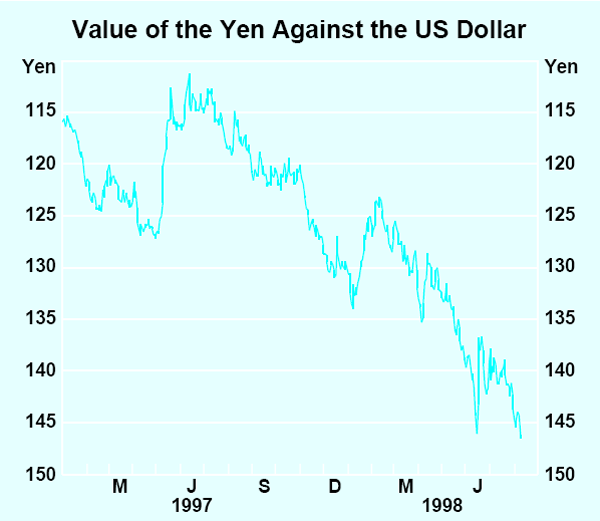
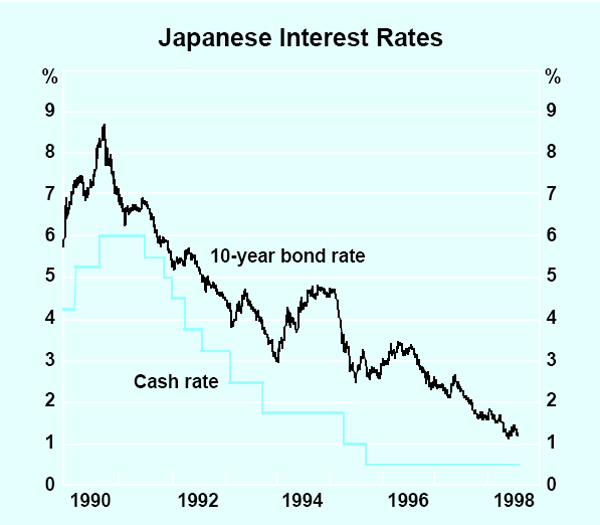
While all countries in the region were affected by these developments, the impact was strongest in countries, including Australia, which had been largely on the periphery of the earlier troubles. Markets seemed to judge that events in Japan would make it harder for these countries to avoid the impact of the turmoil. Some market participants promoted the view that the process would eventually lead to devaluation by China and the breaking of the Hong Kong dollar's peg to the US dollar. Not unexpectedly, this saw a great deal of pressure on Hong Kong markets at times.
Most of the east Asian economies that were at the centre of the first wave of problems in the second half of 1997 were less affected in this latest phase. In part, this is because their trade and capital accounts had already adjusted sharply. Two of the countries in particular – South Korea and Thailand – weathered the latest regional problems relatively well. Their exchange rates have appreciated in recent months, to the point where the net depreciation since the start of their crisis in mid 1997 has been reduced to about 30 per cent. Short-term interest rates, which had risen to around 25 per cent at the peak of their crisis in December/January, have fallen sharply. In South Korea, they are down to 11 per cent, a little below pre-crisis levels (Graph 3). In Thailand also, rates are around their pre-crisis levels.
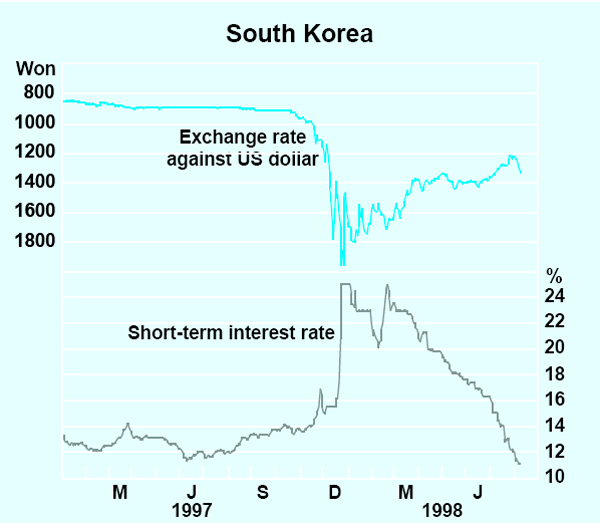
In contrast, the economic and financial situation in Indonesia has continued to slip, with the forces set in train by the initial collapse of the exchange rate last December/ January proving very destructive in terms of both the political and economic structure. The appointment of a new President and the subsequent announcement of a new agreement with the IMF have not yet produced any marked turnaround; the exchange rate of the rupiah remains around 13,000 to the US dollar, less than 20 per cent of its pre-crisis level, and short-term interest rates have risen to about 60 per cent, broadly in line with the rise in inflation.
The one aspect of financial markets in all Asian countries that remains very weak is share markets. Most countries in the region recorded new lows in share prices in the latest quarter, with cumulative falls since the middle of 1997 of about 50 per cent (Graph 4).
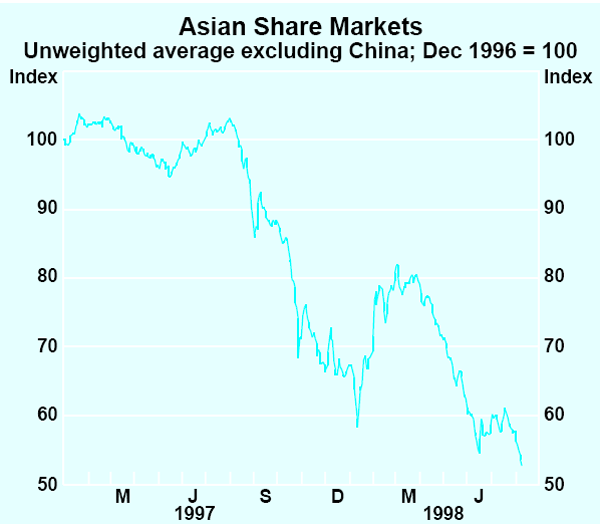
The economic impact of the regional financial crisis has been seen in some sharp declines in production and substantial adjustments in current account positions. The impact has so far been largest in Thailand, Indonesia and Korea. At the same time, it is becoming clearer that a wider group of countries, which escaped the worst of the earlier financial turbulence, are now experiencing a significant economic impact.
For the initial crisis-affected group – the ASEAN-4 and South Korea – the process of macroeconomic adjustment has been necessarily rapid. The abrupt reversal of capital flows to these countries meant that their current account positions had to shift rapidly into surplus. Much of this adjustment took place through lower imports (Graph 5), and was brought about by very large reductions in domestic demand. The size of some of the adjustments has been exceptionally large. Korea's trade position moved by the equivalent of 12 per cent of GDP, and there were similar movements in Thailand and Indonesia. Domestic demand in Korea over the year to March declined by around 28 per cent.
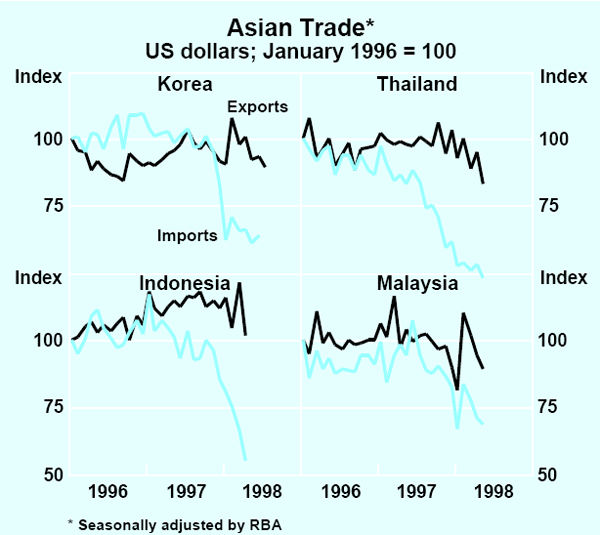
In some countries, there are tentative signs that this initial period of rapid adjustment may have largely run its course. Levels of industrial production in Korea and Thailand, having declined by around 15–20 per cent from pre-crisis levels, have been more stable in recent months (Graph 6). Imports are also showing some signs of stabilising, having fallen by more than 30 per cent in both countries. Exports from Korea are now recovering strongly in volume terms, although declining prices mean that, in US dollar terms, they have been flat. In contrast to the experience of these other countries, the latest data for Indonesia point to continued economic contraction. National accounts data record a GDP decline of 17 per cent over the first two quarters of 1998, after a flat performance during the previous year, and imports have continued to fall rapidly.
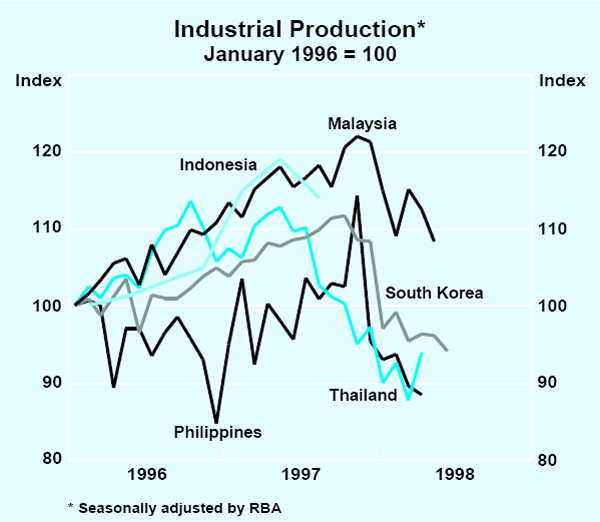
The sharp currency depreciations in these countries have led, in varying degrees, to increased inflation although, in most cases, it remains well contained. In Korea, the impetus to inflation was concentrated around the end of 1997 and the early months of 1998. More recently, consumer prices in Korea have stabilised, probably reflecting the very weak demand conditions and surplus productive capacity in that country. In other countries inflation has come down from recent peaks but continues to run at a higher rate than in the pre-crisis period. The largest increase has taken place in Indonesia, where consumer prices over the year to July rose by around 70 per cent.
The wider impact of the crisis on other countries in the region is now starting to be seen more clearly. In Hong Kong, GDP declined in the first quarter of 1998 by more than 4 per cent, following a fall of 1½ per cent in the previous quarter. Singapore has recorded close to zero growth over the past two quarters, and growth in China and Taiwan has slowed appreciably (Graph 7).
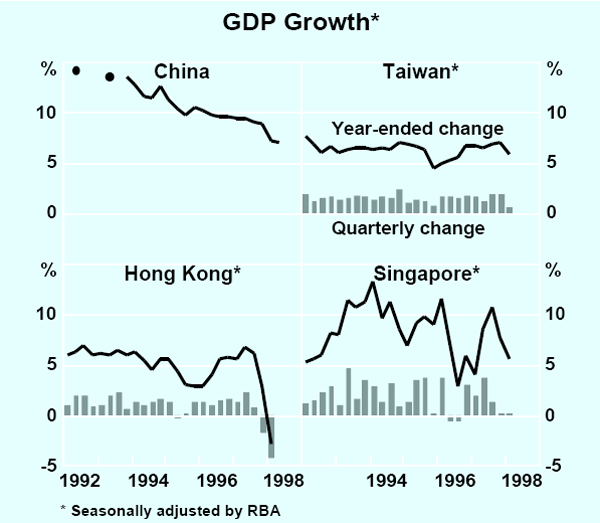
Several factors are contributing to this more general weakening of regional economies. Declines in asset prices have become widespread across the region, in many cases amplified by the higher interest rates put in place to resist currency depreciations. Another factor is loss of export competitiveness. For China and Hong Kong, which have maintained fixed exchange rates to the US dollar, there has been a significant loss of competitiveness against producers from other countries in the region. This is likely to have contributed to the weakening of their export sales over recent months. To a lesser extent, Singapore and Taiwan have also lost competitiveness in foreign markets, having had smaller currency depreciations than those of the initial crisis-affected group. In addition, the Singaporean economy, which is particularly dependent on intra-regional trade, is being significantly affected by the downturns in Indonesia and Malaysia. The extent and likely duration of this general slowing of regional economies have not yet become clear. Much will depend on developments in Japan, which is by far the region's largest economy. In that regard, recent developments are not encouraging.
The Japanese economy continued to weaken in the first half of 1998, prompting the announcement of further policy measures by the Japanese government. National accounts data for the first quarter recorded a fall in GDP of 1.3 per cent, confirming earlier signals of declining demand and output (Graph 8). This result reflected a significant fall in business investment and a decline in exports, following strong export growth in 1997.
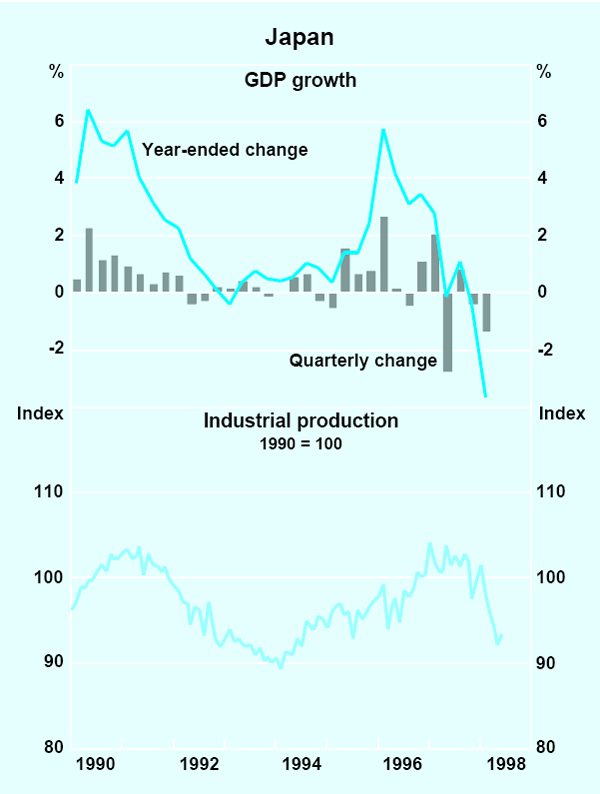
Most indicators are continuing to point to a difficult environment for Japanese businesses. According to the Bank of Japan's Tankan survey, business confidence deteriorated further in the June quarter, to be at levels below the trough reached in the early 1990s. Unsold inventories are at a high level, and industrial production declined further in the June quarter. Consumer confidence is also at low levels, and unemployment has increased to a post-war high of 4.3 per cent.
The deterioration in conditions over the past year has reflected a combination of circumstances including the decline in intra-regional trade, the substantial fiscal policy tightening implemented during 1997, and the poor condition of the Japanese banking system. Weak demand conditions in turn have contributed to declines in inflation from already-low levels. The level of consumer prices was almost unchanged over the six months to June, while wholesale prices over that period declined at an annual rate of around 2 per cent. In these circumstances of weak demand and flat or falling output prices, it is very difficult for businesses to generate increased cash flows. The lack of growth in nominal incomes and spending in the economy, in turn, makes it difficult for businesses and banks to improve their balance sheets and is reinforcing the reluctance of Japanese banks to lend. The volume of bank loans outstanding by Japanese banks has been declining for the past two years.
In this environment of declining demand and financial contraction, there have been widespread calls to support growth through fiscal expansion and banking-system restructuring. A fiscal package announced in April contained measures equivalent to around 3 per cent of GDP, aimed at providing a significant boost to domestic demand through tax cuts and new spending. More recently, Prime Minister Obuchi has proposed an additional set of tax cuts to those announced in April. In June, the government announced a restructuring program for the banking system. The restructuring plan involves using a new regulatory agency to assess the viability of all banks, and will provide for the takeover of non-viable banks by publicly funded ‘bridge banks’. It is proposed that these will continue to lend to creditworthy borrowers, assist in the disposal of non-performing assets, and allow the performing assets of failed banks to be transferred to viable institutions. Public funds for the bridge banks are expected to come from the ¥30 trillion already allocated for bank recapitalisation, of which only a small proportion has so far been taken up.
Prospects for the Japanese economy will depend heavily on the effectiveness with which this program is implemented. International experience suggests that effective bank recapitalisation is an important condition for any sustained recovery from a banking crisis of these proportions. It also suggests that, even with a well-designed restructuring program in place, progress is likely to be slow. Most observers are expecting output of the Japanese economy to be lower in 1998 than in 1997.
Rest of the world
Outside the Asian region, the crisis has had both positive and negative effects. The positives are most clearly evident in the United States, where the Asian crisis, by contributing to a stronger US dollar and falling world commodity prices, has helped to cap inflationary forces. This has allowed the US Federal Reserve to sustain lower interest rates and a faster rate of growth in domestic demand than would have been possible otherwise. US bond yields have fallen to around 5.4 per cent, much the same as the cash rate, resulting (unusually for this stage of the economic cycle) in a flat yield curve. The effects on the US share market, on the other hand, have been mixed: there have been some benefits from lower interest rates but the profit results of US companies are increasingly showing signs of adverse impacts from Asian competition. Overall, US share prices have fallen around 8 per cent from recent peaks (Graph 9).
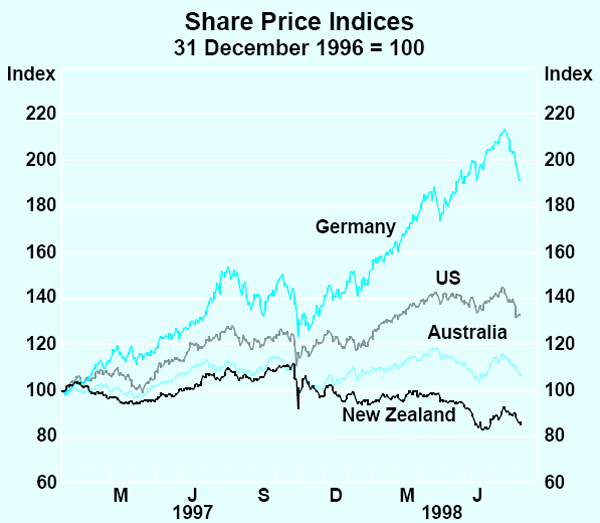
The US economy has continued its strong gains in the first half of 1998. Real GDP rose at an annual rate of 4 per cent in the first half of the year, supported by robust growth in domestic demand. Consumer spending has been buoyed by expanding job opportunities, increasing real incomes and high levels of wealth. Higher household wealth, combined with low mortgage interest rates, has, in turn, boosted housing demand. Business fixed investment has also been brisk, as firms have taken advantage of conducive financial conditions to expand capacity.
While the strength of domestic final demand seems to have continued, the Asian crisis is acting to moderate growth. The combined effects of the appreciation of the dollar and weaker external demand have already seen a sharp increase in the trade deficit, with both a rapid rise in imports and a fall in exports.
External factors will continue to reduce growth in the remainder of the year, but it is unclear whether this will be sufficient to forestall inflation risks. The extraordinary tightness in the labour market has intensified in recent months; the unemployment rate, at 4.5 per cent in July, has now been below 5 per cent for the past year and earnings growth has picked up accordingly. So far, however, this has failed to translate into rising consumer price inflation, because the strength of the US dollar and falling prices for raw materials have offset higher labour costs.
Economic activity has continued to strengthen in the continental European economies as the emerging recoveries have become more domestically driven. In Germany, real GDP rose strongly in the March quarter, as consumers brought forward expenditure ahead of the April consumption tax increase, and equipment investment rose strongly. Recent retail sales gains suggest the economy has maintained sufficient momentum to weather the tax increase, and there have been signs of recovery in the labour market. In France, real GDP is growing at its fastest pace in three years, with strong employment gains fuelling consumption. The unemployment rate has fallen below 12 per cent for the first time since 1996.
In the United Kingdom, growth in domestic demand remains strong, but is being partly offset by falling net exports, reflecting the appreciation of the pound over the past two years. The Bank of England raised short-term interest rates by 25 basis points in June to 7½ per cent, citing mounting labour market pressures and an inflation rate above target as key concerns.
The gathering pace of economic expansion is one reason that European markets have been least affected by Asia, with share markets in particular remaining stronger than elsewhere. Europe has also been more preoccupied by the decision on the group of countries to join the Euro in 1999. The 11 countries joining are (in order of GDP size) Germany, France, Italy, Spain, the Netherlands, Belgium, Austria, Finland, Portugal, Ireland and Luxembourg.
Australian Financial Markets
The Australian dollar
The most visible impact from Asia on Australian financial markets has been the fall in the Australian dollar. It is down from around US75 cents in mid 1997 to about US60 cents at present (Graph 10). This fall has taken place in two phases, in line with the two phases of the Asian crisis. The first reflected mainly the events in east Asia, culminating in the sharp depreciation of the Australian dollar in late 1997/early January, to around US63 cents. It recovered from there to around US68 cents by early April, but then fell to a low of US58 cents in June on the back of events in Japan.
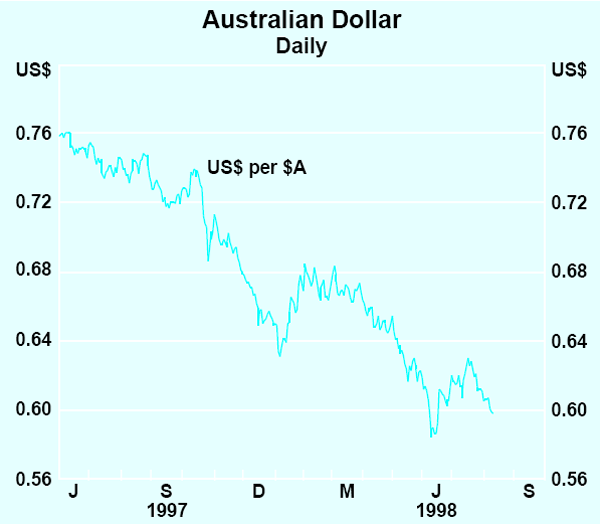
Through most of this period the Bank did not intervene in the market, recognising the underlying economic factors at work and the close connection with events in Asia. In fact, throughout this period, the Australian dollar, in common with many other currencies in the region, showed a remarkable tendency to move very closely with the yen (see Box).
In early June, however, the Australian dollar's fall accelerated, causing it to decline even against the yen, which was itself falling sharply. Two main factors were responsible. First, participants in the market began to believe that the Australian authorities were happy to see the dollar continue to fall. Second, and perhaps related to these developments, hedge funds stepped up their profile in the market. This caused a reduction in market liquidity, as other market players were unwilling to trade on a normal two-way basis while these funds were selling aggressively.
Against this background, the Reserve Bank intervened in the market, buying $2.6 billion dollars in local currency during June. The Bank's presence acted as a counterweight to the hedge funds and restored a normal two-way flow of business although, on balance, the exchange rate continued to fall, eventually reaching a low of US58.1 cents. The turning point in the market came with the intervention by the US Federal Reserve to support the yen exchange rate; this caused a sharp rise in the yen and the Australian dollar moved up with it. Subsequently, the Australian dollar continued to recover, even though the yen steadied, as earlier sellers turned some of their positions. By end June, the Australian dollar was around US62 cents, a level it remained at or above during most of July, before falling to around US60 cents in early August as the yen weakened again.
Market interest rates
The weakness in the exchange rate in June led to a reappraisal within financial markets about the outlook for monetary policy. This was most clearly reflected in short-term interest rates, which, for much of the first half of 1998, had continued to factor in some possibility of an easing in monetary policy. The heightened pressure on the exchange rate in early June saw the yield on 90-day bills, which had been a little below the cash rate, rise sharply at one stage to 5.8 per cent. This level implied a strong market expectation that monetary policy would be tightened. As the exchange rate subsequently moved from its lows, 90-day bill yields returned gradually to around 5.1 per cent (Graph 11).
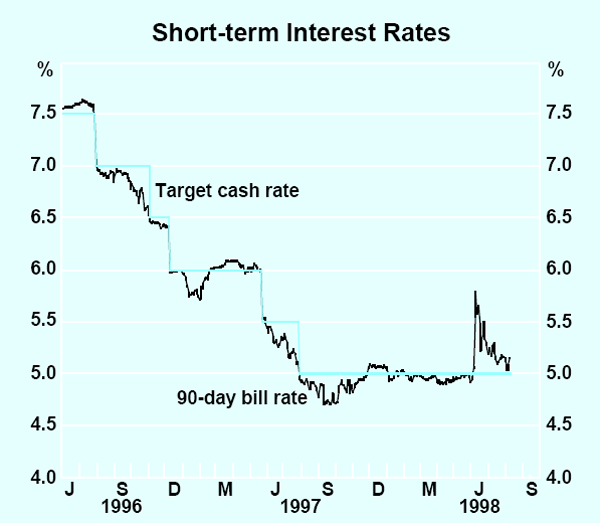
Box: The Australian Dollar and the Yen
From its float in 1983 until recently, the Australian dollar had traditionally been regarded by financial markets as being part of the US dollar bloc. As can be seen in Graph A1, weekly movements of the Australian dollar and the US dollar through most of this period had a high correlation (averaging 0.74).
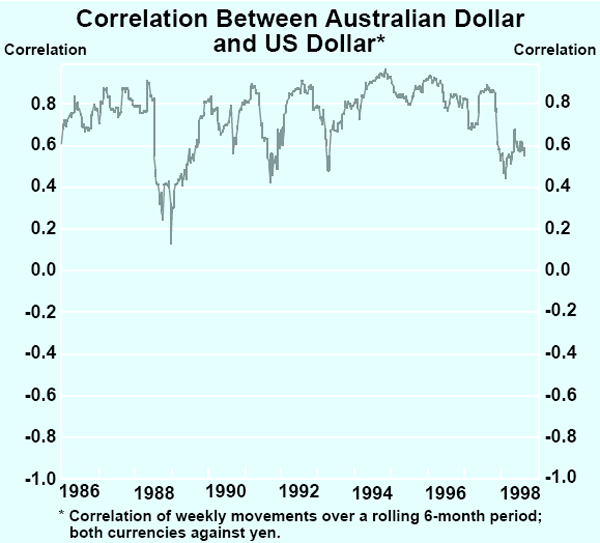
The tight link between the Australian and US currencies owed in part to the close relationship between the Australian and US economies, particularly the similarity of the cyclical development of GDP in the two countries (Graph A2). The tendency for dealers to trade the Australian dollar in line with commodity prices, themselves strongly correlated with US economic growth, may also have contributed to the link, although the correlation of the Australian dollar with the US dollar has been significantly higher than its correlation with commodity prices. Historically there has been no similarity between cyclical movements in GDP in Australia and Japan (Graph A3).
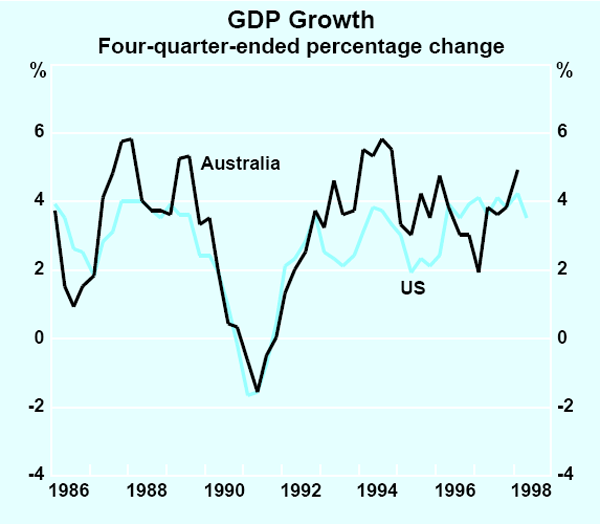
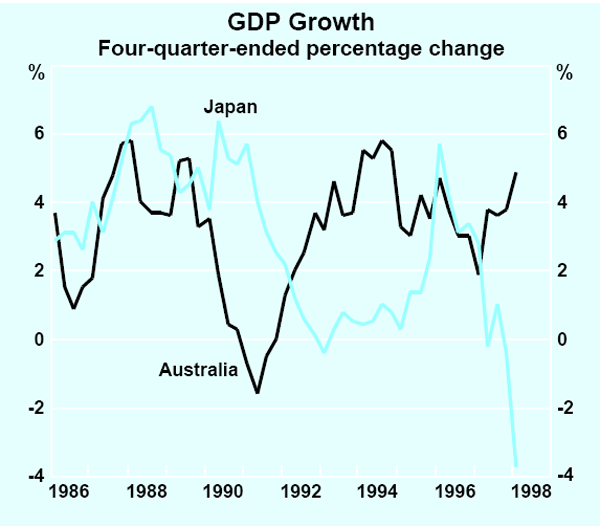
Since mid 1997, when the float of the Thai baht precipitated the exchange rate crisis in Asia, there has been increased talk in the market of the Australian dollar (and several other regional currencies, including the Singapore dollar and Taiwan dollar) now having moved into a yen bloc. Over this period, there has been a close relationship between the Australian dollar and the yen, with the Australian dollar trading in a narrow range between 83 and 88 yen (see Graphs A4 and A5).
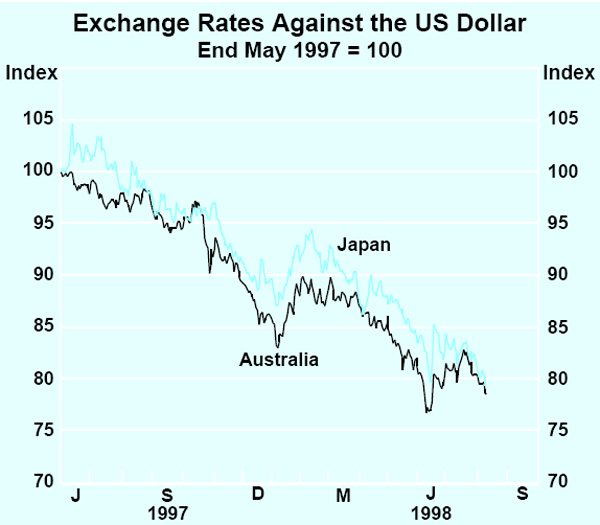
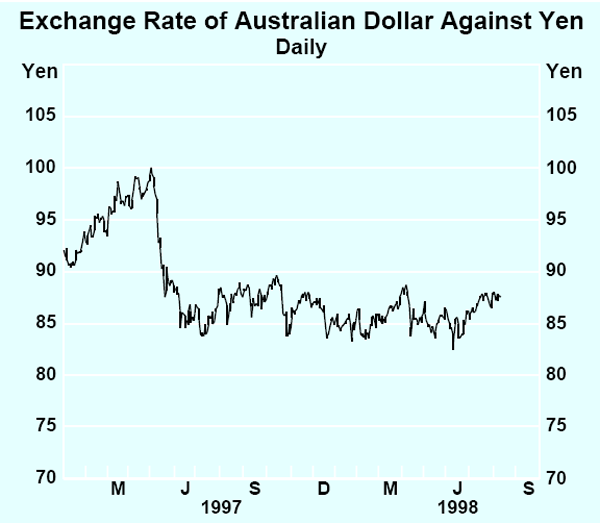
The reasons for this sudden shift in perception are not entirely clear, but are no doubt related to the view that if the Japanese economy does badly, then the rest of the Asian region, including Australia, will suffer. One variation of this is that a falling yen will ‘bring down’ the Chinese yuan, the Hong Kong dollar and, in turn, a number of their competitors. While Asian events are having a significant impact on Australia, it needs to be kept in mind that the trade links to Asia are longstanding and, despite them, the Australian economy has typically behaved more like the US economy than Asian economies. This has continued to be the case in the past year. The summary contained in Table A1 shows the remarkable similarity between Australian and US economic performance, and the complete lack of similarity between either of those two countries and Japan.
| Australia | United States | Japan | |
|---|---|---|---|
| Economic activity | |||
| Growth in domestic final demand(a) | 4.3 | 5.6 | −5.0 |
| Growth in GDP(a) | 4.9 | 3.5 | −3.7 |
| Change in unemployment rate over past year (percentage points) |
−0.4 | −0.4 | 0.9 |
| Change in employment(b) | 2.2 | 2.6 | −1.1 |
| Trade | |||
| Real growth in imports(a) | 11.5 | 11.8 | −3.2 |
| Real growth in exports(a) | 2.7(c) | 0.8 | −1.1 |
| Current account balance (per cent of GDP) | −5.4 | −2.3 | 3.0 |
| Financial | |||
| Inflation rate (core)(a) | 1.6 | 2.2 | −0.3 |
| Share price index (% change since 1 Jan 1995) | 36 | 124 | −21 |
| 10-year bond yields (per cent) | 5.6 | 5.4 | 1.2 |
| Short rates (per cent) | 5.2 | 5.0 | 0.8 |
| Budget balance (per cent of GDP) | 0.2 | 0.1 | −3.1 |
| (a) Four-quarter-ended percentage change. (b) Twelve-month-ended percentage change. (c) Excludes RBA gold. |
|||
As can be seen from Graph A6, there have been other periods in the past when the correlation between the Australian dollar and the yen has risen. But they have always been short lived. The average correlation between the two currencies over the post-float period has been close to zero.
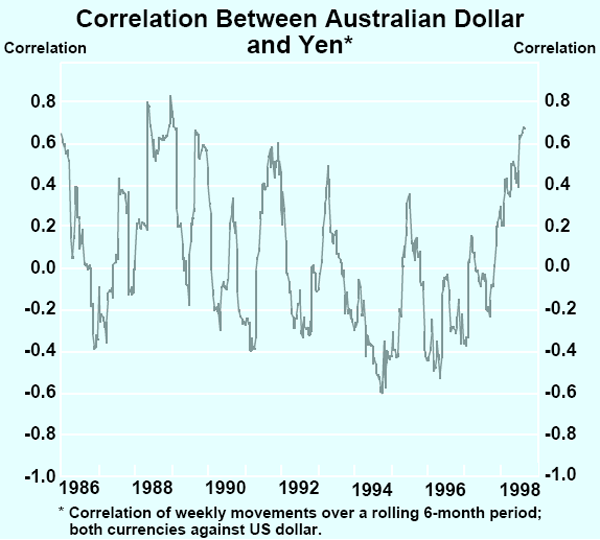
Looked at another way, since the mid 1980s, the yen has been through four broad phases: it appreciated from 1984 through to 1988, then depreciated up until early 1990, resumed its appreciation between 1990 and mid 1995, and then began to depreciate again. In each of these phases until mid 1997, the Australian dollar showed no sustained tendency to move with the yen.
| Yen | Australian Dollar | |
|---|---|---|
| Feb 1985 – Jan 1988 | 116 | 3 |
| Jan 1988 – Apr 1990 | −24 | 4 |
| Apr 1990 – Apr 1995 | 99 | −2 |
| Apr 1995 – June 1997 | −28 | 3 |
While it is understandable that the exchange rate of the Australian dollar reflects developments in Asia, the closeness of the link to the yen that has developed over the past year seems difficult to justify on the behaviour of the two economies. It is possible that the increased correlation is simply a short-term phenomenon, as experienced on several occasions in the past, rather than the start of a new pattern. For the correlation to be sustained, there would need to be a greater correlation in the economic performance of the two economies, and at this stage there is no evidence that this will be the case.
Money markets in Australia were also affected in the June quarter by the introduction of real-time gross settlement (RTGS) for interbank payments in Australia, which resulted in a temporary rise in banks' demand for liquid funds. This saw the cash rate move above its target of 5 per cent for a time, and the yield on Treasury Notes, which are eligible for purchase by the Reserve Bank in the course of its market operations, move to 50 basis points below that for bank bills (from normally about 10 basis points below). As banks grew more accustomed to operating under RTGS, these pressures subsided.
The pressures on market yields arising from the fall in the exchange rate were less apparent in the bond market than in short-term yields, although bond yields did rise to some extent in June. This rise partly reversed earlier declines, which had reflected a number of factors: the expected negative impact of the Asian situation on the local economy, associated concerns about the possibility of global deflation, and the projected fall in the stock of bonds on issue reflecting the expected run of Budget surpluses and the proposed sale of the remainder of Telstra. After reaching a low of 5.3 per cent in early June, the yield on 10-year bonds rose to 5.8 per cent by mid June, then moved back to around 5.5 per cent subsequently (Graph 12).
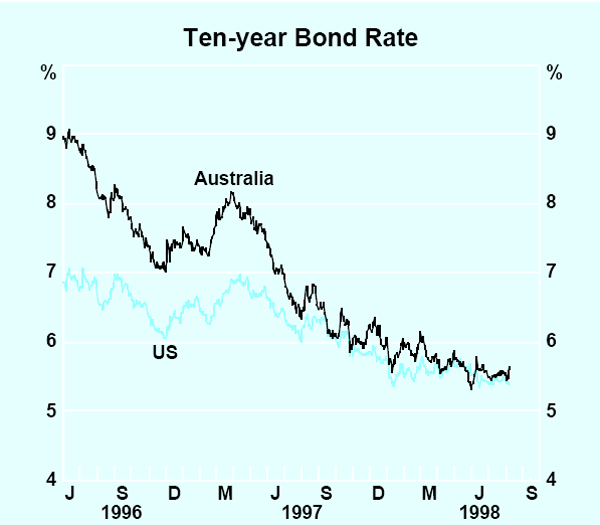
At their low point in early June, bond yields in Australia were below yields in the United States, but the rise in yields associated with the fall in the exchange rate again lifted them above US yields. In early August, the margin of 10-year bonds in Australia over 10-year US Treasuries was about 20 basis points, still well below the historical norm. The rise in Australian short-term interest rates relative to those in the United States was more pronounced, but has now been largely reversed.
The share market
The Australian share market has been volatile in recent months. After rising quite strongly in the first four months of 1998, in line with the lift in world share markets generally, it fell by over 10 per cent by mid June. The main factors underlying this fall were renewed pessimism about Asia, due to the problems being experienced by Japan, and the turn in expectations about interest rates in Australia following the fall in the exchange rate. Subsequently, calmer conditions returned in Australia, and helped by the US market reaching new highs in July, Australian share prices recovered. The rise, however, was narrowly based, being attributable mainly to share prices of a small number of large companies. Subsequent weakness in world share markets over late July and early August, reflecting renewed concerns about Asian markets, saw share prices in Australia return to close to their June lows. Prices of resource stocks have been weaker than average, as markets have judged that prospects for profits of resources companies have been particularly weakened by the malaise in Asia. The index of share prices in the resources sector has fallen by 18 per cent since April, compared with a fall in the All Industrials of 2 per cent.
Domestic Economic Activity
Growth in output of the Australian economy is now slowing from the solid pace recorded during 1997 and into the early part of 1998. Over the year to the March quarter, real output increased by a little under 5 per cent, and growth in the non-farm economy was somewhat stronger than that. There have been a number of signs that the economy is now easing back to a more moderate pace of growth. According to the national accounts, there was a sharp slowing in private spending in the March quarter, while an unusually large volume of output in the quarter was absorbed by stockbuilding (Table 1). Although more recent indicators suggest that the slowing of private spending depicted in the accounts is exaggerated, the indicators generally confirm the economy's transition from above-trend to below-trend rates of growth. The labour market, meanwhile, continues to benefit from the economy's strong performance over 1997 and early 1998, and unemployment remains below the levels of a year ago.
| March quarter 1998 | Year to March 1998 | |
|---|---|---|
| Private final demand(b) | −0.2 | 5.7 |
| Consumption | 0.0 | 4.6 |
| – Goods | −0.2 | 3.9 |
| – Other(c) | 0.0 | 6.7 |
| Dwelling investment | 0.3 | 12.5 |
| Business fixed investment(b) | −2.3 | 7.6 |
| – Equipment(b) | −6.4 | 11.3 |
| – Non-dwelling construction(b) | 9.7 | −0.7 |
| Public final demand(b) | −1.8 | −0.6 |
| Increase in private non-farm stocks(d) | 1.6 | 2.1 |
| Net exports(d)(e) | −1.1 | −1.9 |
| GDP(E) | 0.7 | 5.3 |
| GDP(A) | 1.3 | 4.9 |
| Non-farm GDP(A) | 1.2 | 5.3 |
| (a) All series are annually chained, except GDP(A) and non-farm GDP(A). (b) Excluding transfers between the public and private sectors. (c) Excluding dwelling rent. (d) Contributions to growth in GDP(E). (e) Excludes RBA gold transactions. |
||
A sharp turnaround in the external sector, evident in weakening export volumes and declining commodity prices, has been the major dampening influence on growth. As noted above, the contractionary impulse arising from the Asian crisis has occurred in two stages – an initial, rapid contraction in the economies first affected by the regional financial instability, and a more delayed slowing of other economies in the region. Much of the impact on Australia's exports to the first group of countries has probably now taken place, and there is evidence of a growing diversification of exports to other destinations. However, the more recent downturns in other regional economies, and particularly Japan, will have some further dampening influence. The deteriorating external situation has also had an adverse impact on business and consumer confidence. The Australian economy is likely to experience a period of below-trend growth while these factors remain in place.
Household income and expenditure
Retail spending showed a small decline in real terms in the June quarter, to be 2.8 per cent higher than a year ago. Over the first half of 1998 retail trade has shown almost no net increase in real terms, following the strong growth recorded in the second half of 1997. The result for the month of June, a fall of 0.8 per cent, incorporates a substantial decline in spending in department stores; this may partly reflect recent changes to the timing of mid-year sales, as there was a similar fall recorded the previous June, followed by a strong bounce-back the next month (Graph 13).
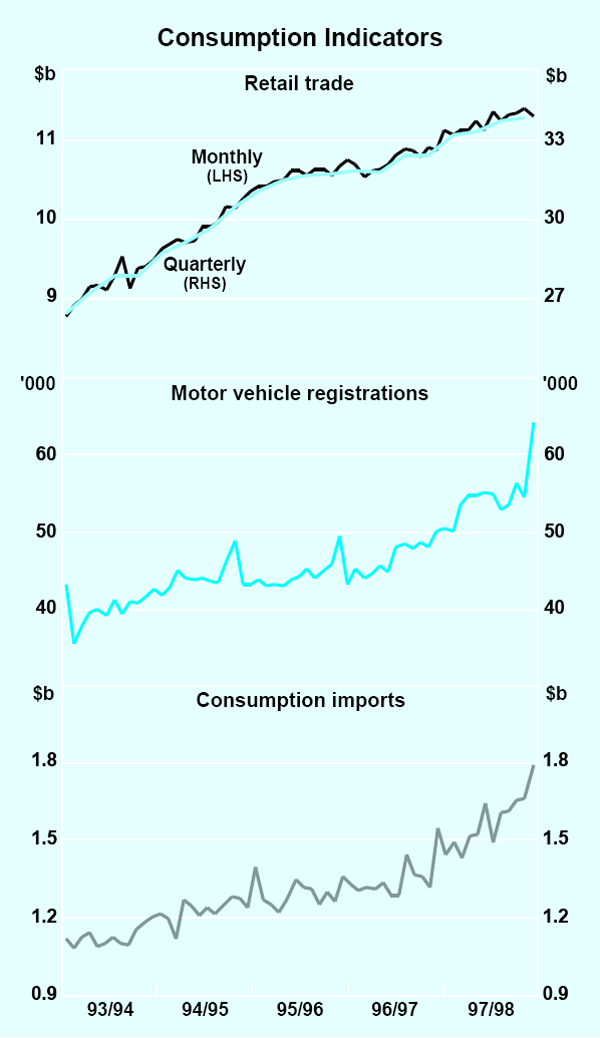
Sales of motor vehicles have again posted some very rapid growth, after easing back a little in the early part of 1998. In June, motor vehicle registrations jumped by 17 per cent; this occurred alongside a rise of 22 per cent in car imports in the month. The renewed growth in sales has been supported by further discounting by retailers and reductions in imported car prices. For 1997/98 as a whole, passenger vehicle registrations were, at over 650,000, the highest on record. It is possible that the increases in car sales occurring at present, by absorbing a higher proportion of disposable incomes, are having a dampening effect on sales of other durable goods.
Consumer sentiment, according to the Melbourne Institute survey, declined through the first half of 1998, although it remains above long-run average levels. Consumers appear to be becoming more concerned about the outlook for the economy and the outlook for unemployment (Graph 14). Their responses are clearly sensitive to the news which is released around the time the survey is being taken but, in broad terms, appear to reflect the likelihood that the economy will grow more slowly in 1998 than it did in 1997. In contrast to sentiment about the economy as a whole, there has been little decline in measures of consumers' perceptions of their own financial situation, which remain well above longer-term averages.
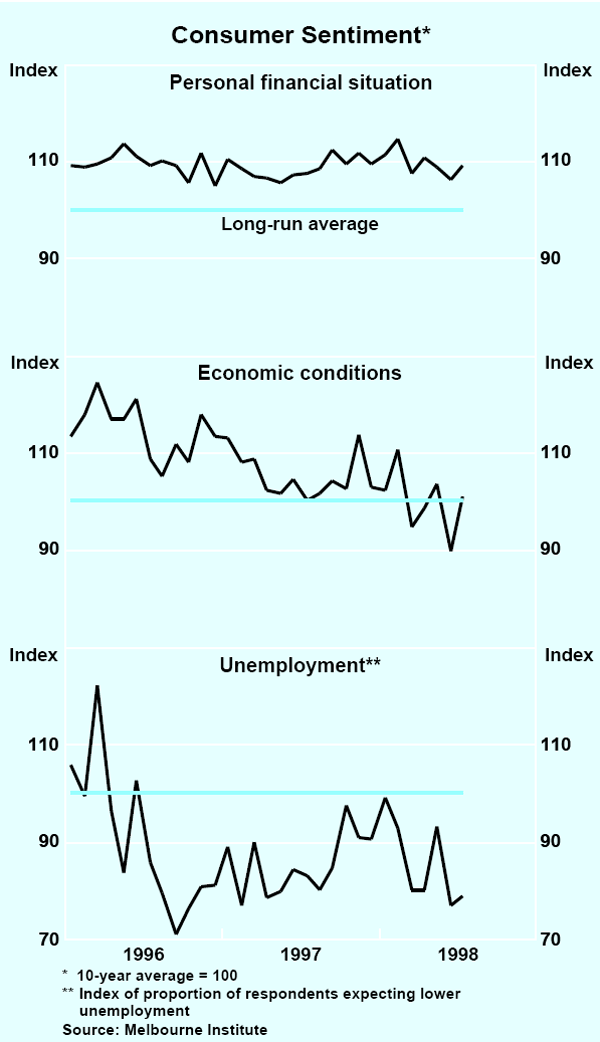
One factor which should help underpin consumer spending in the latter half of 1998 is the AMP demutualisation. Insofar as policyholders perceive their allocation of shares as amounting to a windfall gain, they are likely to use a proportion of the proceeds from the demutualisation to boost spending. With the market price of AMP shares towards the top end of earlier expectations, the addition to household wealth will be somewhat larger than was initially estimated. To some extent, however, the effect on spending may be dampened by current consumer concerns about the outlook for the domestic economy, particularly given that household saving has been declining recently. On balance, our earlier estimate that the demutualisation would boost consumer spending by a few tenths of a per cent of GDP remains plausible (for further details, see the May 1998 Semi-Annual Statement, Box B).
The housing market
Housing construction activity has increased strongly over the past 18 months, supported by high levels of affordability. In the March quarter, the number of housing commencements was 10.1 per cent higher than a year earlier, and building approvals data point to a further solid increase in the June quarter. Growth in activity has been boosted by continued increases in the value of the average new dwelling constructed, and by strong growth in spending on alterations and additions.
Notwithstanding this recent strength, the likely extent of future expansion in the current housing upswing is difficult to gauge, with forward indicators of housing demand giving conflicting signals. After increasing strongly during much of 1997, loan approvals for housing appeared to level out in the early months of this year, before showing a strong further rise in June (Graph 15). The increase in loan approvals in June may have partly reflected efforts by borrowers to take advantage of existing low interest rates, amidst widespread talk that intermediaries' interest rates might rise. These concerns may have brought forward some demand for loans, as well as encouraging a strong increase in refinancing as borrowers shifted from floating to fixed-rate loans. As discussed in detail in the section on Financial Conditions below, there were some small increases in fixed housing loan rates, which reflected increased funding costs in financial markets.
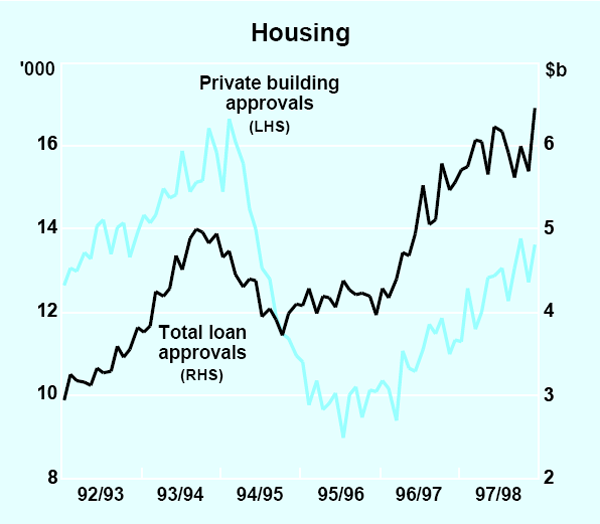
Local government building approvals, meanwhile, have continued on a strong upward trend, with growth in the alterations and additions component particularly pronounced. The normal pattern is that trends in housing finance lead those in building approvals, and so it would be unusual for the current strong growth in building approvals to continue without some renewed growth in finance. A plausible interpretation of these trends is that the housing upswing may be maturing, particularly given that the rate of new construction is approaching a level somewhere near the trend rate of expansion in demand for new housing. This would also be consistent with other evidence that demand conditions in the market for existing housing are now easing a little in some areas.
Recent trends in house prices are pointing to an easing of excess demand in those areas where it had initially been concentrated, particularly in the inner suburbs of Sydney and Melbourne. After a period of rapid growth during 1997, house-price increases in these inner city areas have eased considerably in recent months. More moderate upward pressures on prices are now working their way across a wider area in the middle and outer suburbs of Sydney and Melbourne, as well as becoming evident in a number of the other capital cities. Available indicators of rental rates and vacancies of residential property are volatile and vary considerably across capital cities but, in general, they provide tentative signs of a mild easing of growth in rents; vacancy rates have picked up a little in some cities, but they remain low. Together, the trends in house prices, rents and vacancies provide little evidence of a significant build-up of either excess demand or excess supply in the housing market at present. Conditions would seem supportive of continued, although somewhat more moderate, growth in housing investment in the period ahead. Given the low level of interest rates, spending on alterations and additions seems likely to remain strong.
The business sector
Production increased strongly in the March quarter following good growth through 1997. A significant part of the March quarter increase in output, however, was recorded as being absorbed in unsold stocks, and the interpretation of this result has an important bearing on the business outlook for later in the year. Some increase in stocks in the March quarter was expected as, according to the national accounts, stocks had been run down over 1997, and surveys had been pointing to a desire by businesses to re-build stocks. A detailed examination of stocks-to-sales ratios at an industry level shows that the increase in stocks in the March quarter largely returned these ratios to around their average levels of recent periods (Graph 16). It is also possible that the large estimate for stockbuilding will be subject to revision – the pattern over the 1990s has been that unusually large initial estimates of the change in stocks have tended to be revised to show less extreme movements. Nevertheless, the magnitude of the increase in stocks in the quarter is, at least in part, suggestive of some unintended stockbuilding having taken place.
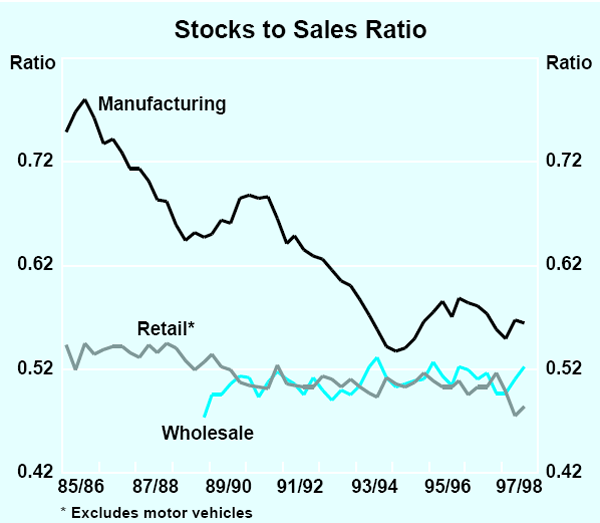
Business surveys have pointed to weaker conditions in the June and September quarters. This appears to be mainly linked to the ongoing crisis in Asia, which has had a large direct effect on export sales and has reduced business confidence. Almost two-thirds of respondents to the NAB Survey of non-farm businesses expect their firms to be affected by developments in the Asian region in the next 12 months. Averaged across all respondents, total sales are expected to be 2 per cent lower than they would otherwise have been on account of developments in Asia. Business confidence, as recorded in the June quarter NAB survey, has declined to a level slightly below the most recent trough reached in March 1996. The decline in this measure of business confidence has, however, been somewhat more marked than the declines in indicators of firms' employment and capital expenditure plans recorded in the same survey (Graph 17). In this respect, there is a parallel with consumer survey results, which suggest that consumers are more pessimistic about the economy as a whole than about their own circumstances. Other business surveys are more pessimistic, particularly those relating specifically to the manufacturing sector such as the ACCI-Westpac and Colonial State Bank surveys.
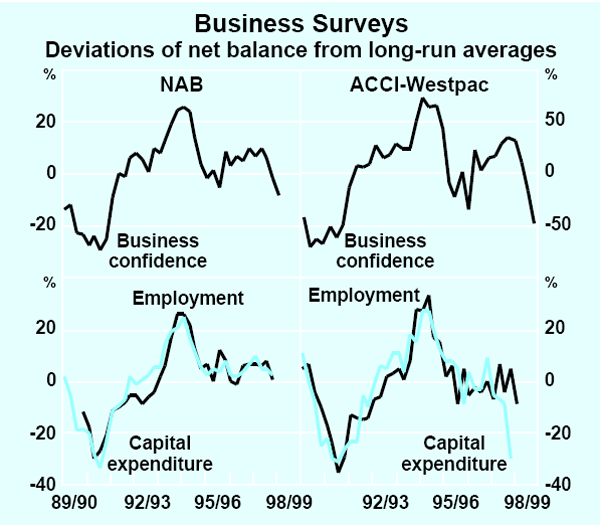
The greater deterioration in confidence in the manufacturing sector is likely to reflect that sector's relatively high exposure to international trade and the loss of export sales to the east Asian region. Employment and profitability in manufacturing have been weaker than in other industries over the past year, with employment recording a decline. As discussed in detail in the section on Balance of Payments below, manufacturing is likely to be one of the areas in which exporters have greatest difficulty in the short term in diversifying into alternative markets to compensate for reduced sales in Asia. The manufacturing-based surveys have been pointing to significant declines in export sales, and balance of payments data confirm the weakness in manufacturing exports over much of the past year, although they picked up in the June quarter. The surveys also suggest a significant decline in manufacturers' investment intentions (generally presenting a more pessimistic outlook in this regard than the ABS capital expenditure survey, discussed below).
Total profitability of the corporate sector, as measured by gross operating surplus, has been gradually declining as a share of GDP since the peak reached in 1996, and is now, at 15 per cent, around its decade average. The recent depreciation of the Australian dollar and consequent increase in Australian-dollar commodity prices would generally imply an increase in profits for mining companies. However, many large companies had hedged the $A/US$ rate prior to the exchange-rate decline, and hence will not receive any boost to profits, at least in the short term. In addition, some companies have a natural hedge, earning most of their income in US dollars but also incurring a high proportion of their costs in US dollars. Therefore, benefits to these companies may also be smaller than in other cases.
If the recent deterioration in business sentiment is to have a significant effect on real activity, it would do so by altering firms' investment and employment plans. Over the past five years, investment expenditure on equipment has grown very strongly. Recent data, however, suggest some reduction in the pace of growth. Estimates from the latest ABS capital expenditure survey for 1997/98 suggest real growth (in annually chained terms) of around 5 per cent over the year to the June quarter, compared with 10 per cent over the preceding year. Estimates for 1998/99 are pointing to a subdued outlook for this type of investment. Based on average realisation ratios, the survey would imply only moderate growth in nominal terms for the year, and roughly flat equipment investment in real terms. This expectation, recorded in the survey conducted in late April and early May, represents a downward revision to the previous outlook recorded three months earlier. Within the total, expectations in the manufacturing sector have been revised upward, although this was from a low level and, as noted above, the manufacturing-based business surveys continue to give a very pessimistic reading.
In contrast to these expectations for investment in equipment, the capital expenditure survey points to a stronger outlook for investment in buildings and structures. This impression is supported by a recent pick-up in private non-residential building approvals. While non-residential approvals are extremely volatile, they have been quite strong in the June quarter, regaining levels recorded in the latter part of 1997 (Graph 18). If sustained, this recent strength in approvals would support reasonably firm growth in construction activity over 1998/99. It also appears that there is quite a large stock of work yet-to-be-done, which should also help underpin further growth in construction activity. This is the case both for non-residential buildings and for engineering construction projects, such as private-sector infrastructure developments.
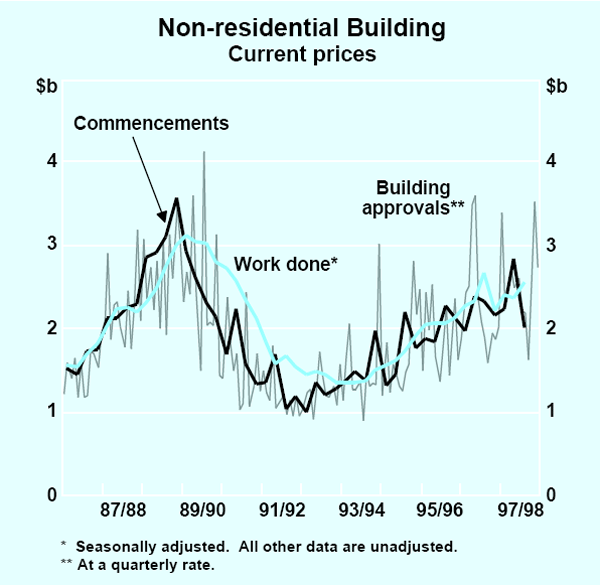
Non-residential construction work is typically very lumpy, and the recent increase in commencements has been concentrated mainly in office, hotel and recreational projects. According to the latest Access Economics Property Monitor, office and hotel projects currently under construction and under consideration are heavily concentrated in New South Wales, although other types of project are more evenly spread geographically. This pattern appears broadly consistent with information on office rents and vacancy rates, which suggest that demand for office space is stronger in New South Wales than elsewhere. The concentration of hotel projects in Sydney, in particular, largely reflects projects which are driven by the expected increase in tourism associated with the Olympic Games. The Property Monitor gives little evidence so far of construction projects being cancelled in the wake of recent declines in business confidence. Between the March and June surveys, plans for only one large development were placed on hold and only a couple of projects were downgraded; the stock of projects under consideration in June remained around the level of a year ago.
Over the past few years, private-sector businesses have funded relatively more of their activities in the form of debt finance. This has been reflected in an increasing ratio of corporate debt to equity. More recently the rate of growth of corporate borrowing from domestic financial institutions has declined, and in the March quarter corporates retired a large sum of foreign debt. Coupled with ongoing equity raisings, this reduced the overall debt to equity ratio in the March quarter. This reversal of the upward trend in corporate leverage may prove to be temporary, however, with a number of large companies recently undertaking share buy-backs.
The labour market
Employment has continued to post solid gains in recent months, following the strong growth in output over 1997 and into the early months of 1998. In July, the level of employment stood slightly more than 2 per cent higher than a year earlier (Graph 19). Full-time employment has been increasing at around the same rate as the total over the past year, recovering from an earlier period of around 18 months without growth. Much of the growth in employment over the past year has been in private-sector service industries, particularly in property and business services, while there have been declines in employment in manufacturing and the public sector. The stronger labour market conditions overall have been reflected in a fall in the unemployment rate over the past year. In July, the unemployment rate was 8.3 per cent, compared with 8.7 per cent a year earlier.
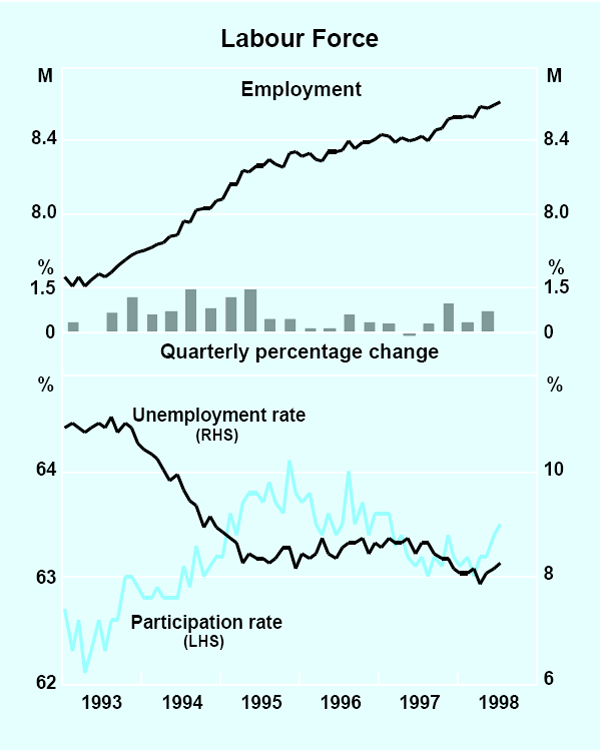
Labour productivity has continued to grow rapidly. According to the latest national accounts, labour productivity per hour worked over the year to the March quarter 1998 was exceptionally strong, increasing by almost 4 per cent. To some extent this result was boosted by differences in timing between the recent increases in output and employment growth, with the pick-up in output growth preceding that in employment (see below); it also appears to be based on implausibly low estimates of the increase in hours worked. Even allowing for these factors, however, it is clear that rapid productivity growth remains an important feature of the current period of economic expansion. Since the start of the economic recovery in 1991, annual productivity growth has averaged just under 2 per cent.
Short-term fluctuations in the rate of employment growth have typically lagged behind those in aggregate output (Graph 20). In broad terms, the recent trends in employment have continued that pattern, with the stronger employment growth that started in the second half of 1997 coming somewhat later than the initial pick-up in output growth. Although the relationship between these two variables is not precise, past behaviour would suggest some additional impetus to employment still to come from the economy's recent strength, before the current slowing in output growth begins to affect the labour market. However, the unknown factor in the present outlook is the extent to which businesses may adjust their hiring plans in light of their more pessimistic assessments of economic prospects. It is possible that, given the publicity surrounding developments in Asia and their adverse effect on confidence, businesses may be somewhat more cautious in their hiring plans than would normally be expected following a strong period of economic growth.
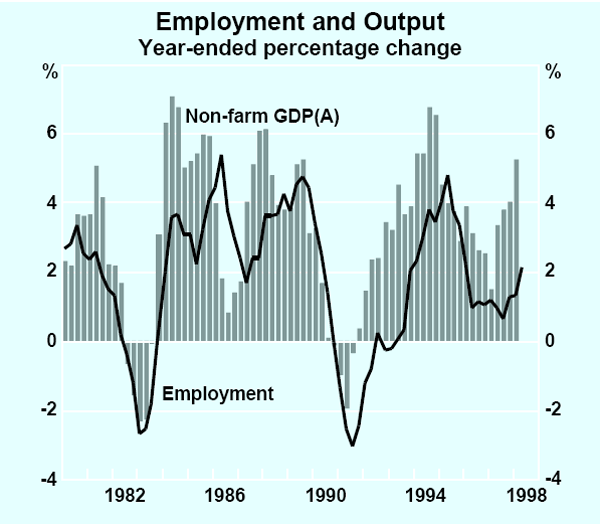
Indicators of prospective labour demand are providing mixed signals at present. According to the NAB business survey, there has been a moderate decline in firms' near-term hiring intentions over the past six months, occurring alongside the more general deterioration in business confidence. Vacancies indicators, however, offer a stronger picture (Graph 21). Both the ANZ job-ads series and the DEETYA Skilled Vacancy Index continue to rise, and are respectively 15 and 22 per cent higher than a year ago. Even stronger growth has been recorded in the ABS vacancies series, which has risen by 28 per cent over the past year, the bulk of this in the past two quarters.
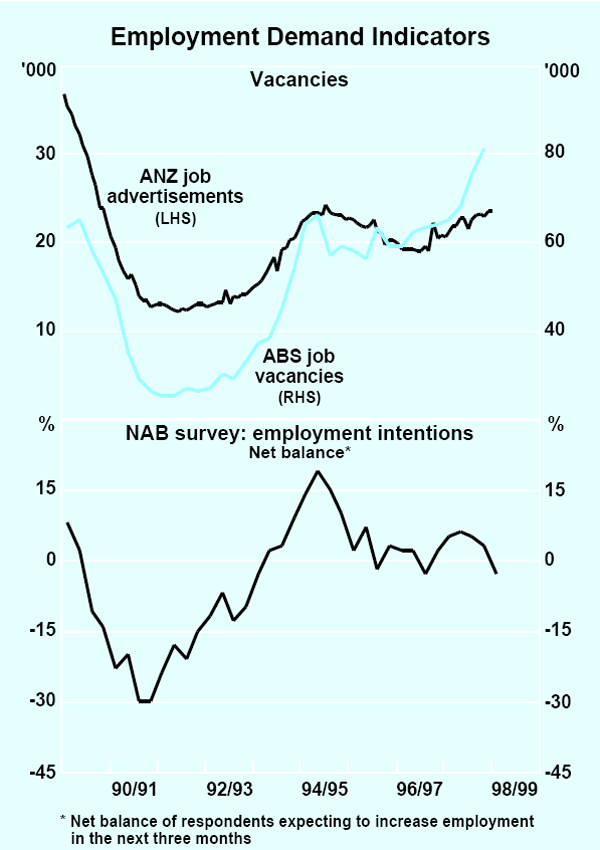
Balance of Payments
The impact of the economic problems in the Asian region are now clearly evident in Australia's external accounts. These events have contributed to a decline in the volume of exports, a fall in Australia's terms of trade and a widening of the current account deficit. Growth in imports remained quite strong in the first half of 1998, showing a sharp increase in June after a few months when they had appeared to be levelling out.
After growing solidly through much of 1997, the volume of exports of goods and services fell by 0.8 per cent in the December quarter and by a further 1.7 per cent in the March quarter, after adjusting for RBA gold transactions. In an underlying sense, the slowing in export growth was probably even more marked, as exports of non-official gold were unusually strong in these two quarters, reflecting the re-export of gold imports from a number of the east Asian countries. The observed weakening in export growth reflected both the direct effect of weakness in demand from the Asian region and the effect of lower farm production. Reasonably solid growth in export volumes appears to have occurred in the June quarter.
Exports of services and manufactures have been the areas most adversely affected by developments in the east Asian region. After falling by nearly 8 per cent in the December quarter, the volume of services exports was flat in the March quarter, and appears to have risen marginally in the June quarter. Manufactured exports fell by 2½ per cent in the second half of 1997 and by a further 4 per cent in the March quarter, but appear to have rebounded in the June quarter. The export of several ferries boosted the June quarter growth but, even excluding these, manufactured exports probably increased by over 3 per cent in the quarter.
Tables 2 and 3 provide an overview of these developments at a regional level. They show that over the year to the June quarter, the value of manufactured exports to east Asia fell by around 15 per cent, while overseas arrivals from east Asia (a good indicator of tourist trade) fell by around 10 per cent. Developments in east Asian markets have thus had a significant impact on total exports of manufactures and services from Australia. These tables also illustrate, however, that exporters have made some gains in sales to other countries; over the past year, growth in exports of manufactures and services to many countries outside the Asian region have been stronger than trend growth rates recorded earlier in the 1990s.
| Average 1990–1995 |
Year to June quarter 1998 |
|
|---|---|---|
| East Asia (incl. Japan) | 20.6 | −14.6 |
| of which: | ||
| Troubled Asia | 22.8 | −48.2 |
| – Korea | 29.0 | −52.7 |
| – Indonesia | 15.0 | −55.9 |
| – Thailand | 23.6 | −44.6 |
| – Malaysia | 25.2 | −47.2 |
| – Philippines | 23.7 | −24.5 |
| Japan | 10.1 | 0.1 |
| Other east Asia | 23.3 | 13.8 |
| United States and Europe | 10.4 | 20.5 |
| New Zealand | 16.4 | 0.0 |
| Rest of the world | 39.9 | 38.2 |
| Total | 16.3 | 6.5 |
| Average 1990–1995 |
Year to June quarter 1998 |
|
|---|---|---|
| East Asia (incl. Japan) | 18.4 | −10.1 |
| of which: | ||
| Troubled Asia | 32.3 | −49.0 |
| – Korea | 64.4 | −78.6 |
| – Indonesia | 31.5 | −40.0 |
| – Thailand | 32.7 | −57.7 |
| – Malaysia | 18.4 | −21.0 |
| – Philippines | 15.0 | −11.0 |
| Japan | 10.3 | 0.5 |
| Other east Asia | 24.0 | 22.1 |
| United States and Europe | 5.5 | 12.2 |
| New Zealand | 5.2 | 14.5 |
| Rest of the world | 8.8 | 16.2 |
| Total | 11.0 | 1.2 |
A sharp weakening in rural exports in the December and March quarters also contributed to the weakening in total export growth. Rural exports fell by over 10 per cent in the March quarter, after having fallen by nearly 4 per cent in the December quarter, and they appear to have been broadly flat in the June quarter. This weakness can be explained largely by a decline in farm production from unusually high levels in 1996/97. Weakness in demand in the Asian countries has also contributed to the weakening in rural exports, as exports of some commodities, such as live cattle and wool, have been particularly concentrated in Asia. In general, however, exporters of many rural goods have been able to find alternative markets for their products to compensate for the loss in demand from Asia.
This diversion has been particularly clear in the case of resources (Graph 22). These relatively homogenous commodities are typically sold into world markets. The available data suggest that lost sales into Asia have been completely offset by increased sales elsewhere, particularly in Europe. As a result, growth in resource export volumes (excluding gold) over the year to June was around 6 per cent, the same as over the preceding 12 months, and close to the average rate of growth in the 1990s.
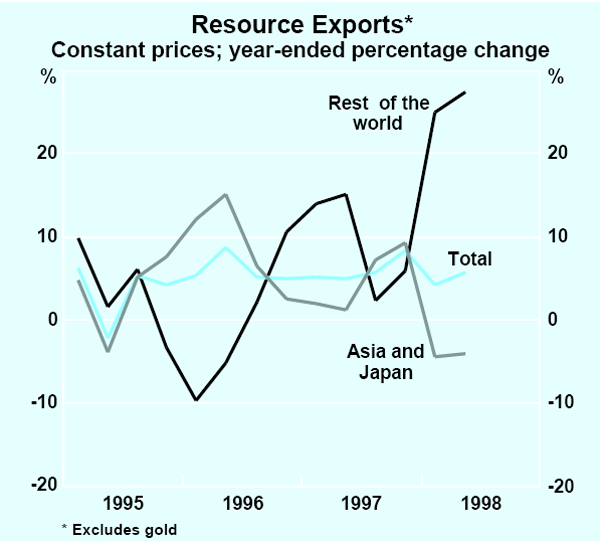
Volatility in the export data, combined with a lack of information about country-specific price developments, imply that month-by-month developments have to be interpreted with care. However, tentative signs are emerging that the worst of the direct effect on Australia of the contraction in demand in South Korea and the ASEAN countries may have already passed. Exports to these countries appear to have stabilised in recent months (albeit at much-reduced levels), while exports to other regions outside Asia have continued to pick up, reflecting both solid demand and improvements in the competitive position of Australian exporters (Graph 23).
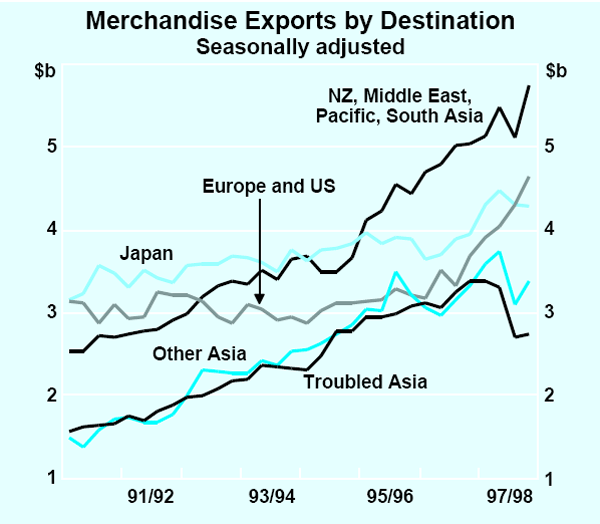
Import demand has remained quite strong in the first half of 1998 although, prior to the sharp increase recorded in June, nominal spending on imports had appeared to be easing. A big part of the latest rise was accounted for by motor vehicles, but there was also significant growth in imports of intermediate goods. The recent strength of imports supports the assessment that domestic demand continues to expand at a reasonable pace. There is little evidence of a widespread acceleration in imports from the troubled Asian economies, although there have been significant increases in certain categories, notably motor vehicles, gold and jewellery – the latter two probably destined for re-export. Overseas departures to many of the troubled Asian economies have also picked up markedly over the past year.
The net effect of these external developments has been to increase the size of the current account deficit (Graph 24). In the March quarter, the current account deficit was 5.4 per cent of GDP, driven largely by a widening in the trade deficit to 1.8 per cent of GDP. In the June quarter, the trade deficit has declined a little, and the current account deficit may have also declined, depending on the size of the net income deficit.
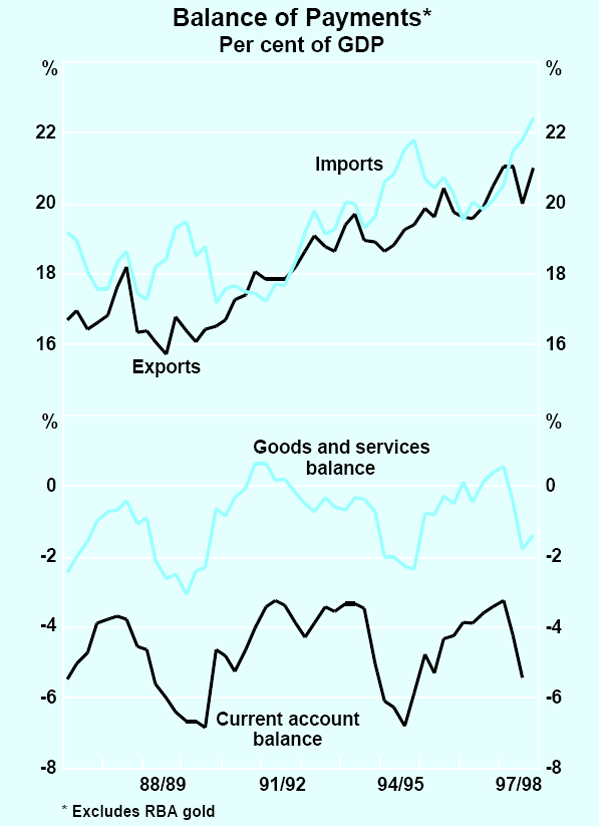
It is notable that the exchange rate depreciation has had little valuation effect on the net income deficit. A bit more than half of the gross external debt is denominated in foreign currencies. It, and the foreign currency debt servicing payments, are therefore subject to valuation effects when the exchange rate changes; currency depreciation increases the debt-servicing costs in Australian dollar terms. However, the effect this has on the net income deficit is being roughly offset by the corresponding valuation impact on foreign assets, since these are of similar magnitude to the foreign-currency-denominated component of external debt. In the March quarter, valuation effects meant that the net income deficit actually narrowed slightly, to $5.0 billion (3.6 per cent of GDP).
Net foreign liabilities rose in the March quarter, with a $6.9 billion increase taking the stock of net foreign liabilities to $323.0 billion (59.9 per cent of GDP); net foreign debt now stands at $224.5 billion (41.6 per cent of GDP). The ratio of income payments to exports remains near its average over the past two decades, at 17.9 per cent.
Commodity prices
After stabilising in the early months of 1998, commodity prices weakened during the June quarter as evidence emerged of a further deterioration in demand in Asia. In US dollar terms, Australia's commodity prices are now around 18 per cent below the peak recorded in the early months of 1997, prior to the onset of the Asian crisis. In SDR terms, the decline has been about 15 per cent (Graph 25). These price falls have been spread across most components, but have continued to be most pronounced for base metals and rural goods. Contract prices of bulk commodities have so far been unaffected by significant price falls, but spot prices have now fallen well below these contract prices in some cases.
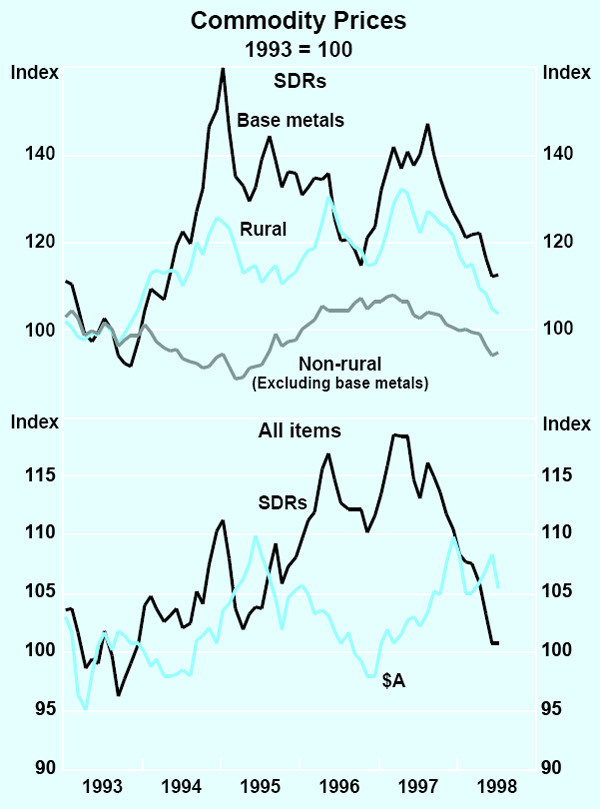
The further recent weakening in the outlook for Asia, particularly outside the initial crisis-affected group, appears to have specifically affected the outlook for wool and base metals. Wool prices have continued to fall sharply, and are now 18.5 per cent below levels of a year ago in Australian dollar terms, inducing some wool producers to switch to prime lamb production. The weakening in base metals prices in recent months has been driven by concern over falling demand in Asia, particularly in Japan.
Influences other than the Asian events also appear to be having a dampening effect on some commodity prices. Oil prices, although fairly stable for the past couple of months, remain nearly 30 per cent lower than levels of a year ago in US dollar terms because of high production levels. In March, members of OPEC agreed to cut production by around 2.6 million barrels a day in order to support prices. Falling wheat prices in recent months mostly reflect increases in world stock levels; stocks have increased over the past year due to the combination of good harvests in many regions and weaker world demand.
Despite the continued weakness in commodity markets, the further decline in the Australian dollar against the major international currencies has meant that, in domestic-currency terms, commodity prices have remained roughly stable in recent months. They are slightly above their average level of the past five years or so.
Financial Conditions
Intermediaries' interest rates
With the Reserve Bank's cash rate target unchanged since July 1997, there have been few changes in interest rates on variable-rate loans in recent months. However, recent volatility in capital market yields has caused some financial intermediaries to adjust rates on fixed-rate loans.
Banks announced increases in June of up to 35 basis points in the interest rate on three-year fixed-rate housing loans, taking this rate to 6.85 per cent. Even so, this rate remains 1.9 percentage points under the previous cyclical low early in 1994, reflecting the trend decline in bond yields over recent years. With fixed-rate loans at historical lows, and markets focusing on the possibility of higher interest rates, the proportion of fixed-rate borrowers rose to around 25 per cent in June, compared to 15 per cent in the previous month.
Interest rates on variable-rate loans, which tend to be priced from the cash rate, have not changed in recent months. Indicator rates on standard variable-rate housing loans from banks remain around 6.7 per cent, where they have been since August 1997, while variable lending rates of mortgage managers are 40 basis points lower at 6.3 per cent. This period of stability in housing interest rates suggests that the period of intense competition in the housing market, driven by mortgage managers' quest to raise market share, has run its course, at least for the time being.
Rates charged on small business fixed-rate loans also rose in June, although some of this was reversed in July. The average indicator rate on three-year fixed-rate loans to small business is up by a net 20 basis points, to 7.2 per cent, over the two months.
Perhaps of more significance, competition in small business finance has intensified over the past year, as banks have reduced indicator rates on variable-rate loans on mainstream lending products and offered products with risk margins linked closely to the type of security that borrowers offer. The average indicator rate for overdrafts fell by about one percentage point over March and April, to 7.7 per cent, even though there was no change in monetary policy. The predominant indicator rates on term loans and overdrafts secured by residential property are 6.9 and 7.2 per cent respectively. These rates are the lowest for ‘widely available’ small business products since the mid 1960s (Graph 26).
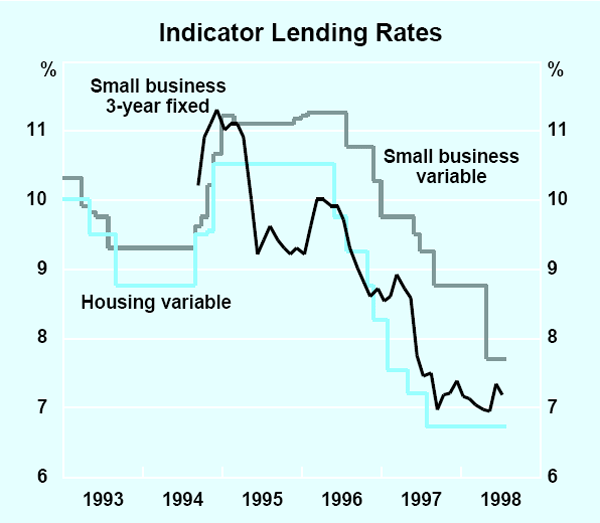
In the March quarter, the average interest rate on small business variable-rate loans, incorporating customer risk margins, was 9.4 per cent. These figures do not yet capture the latest reductions in small business indicator rates, which were announced late in March and early in April. Banks' margins on small business lending, which have narrowed since mid 1997, might narrow further in figures for the June quarter and beyond as recent reductions in indicator rates begin to affect the figures.
While there has been no widespread move to lower indicator rates on variable-rate loans for large business, two banks also reduced these rates when they announced reductions in small business rates. While the average indicator rate on large business variable-rate loans, at 8.0 per cent, is now higher than the corresponding rate for small businesses, the all-up borrowing cost to large business remains lower than for small businesses since customer risk margins for the former are, on average, finer than those for the latter. This is evident in the average interest rate paid by large businesses for variable-rate loans, which was 7.9 per cent in March 1998.
Some signs of competition among banks for personal lending have also become evident, especially for secured and unsecured fixed-rate personal instalment loans. In recent months, the interest rate on secured fixed-rate personal loans has been reduced by 2.1 percentage points to 9.9 per cent, and that for unsecured fixed-rate loans has fallen by 1.2 percentage points to 11.1 per cent. There has been no change to interest rates generally either on variable-rate personal loans or credit cards since September 1997, following the last easing in monetary policy. Some banks have made some special offers available on credit cards to new customers.
Banks' interest spreads
With the growing competition in lending markets, banks' interest spreads have narrowed.[1] In the period of financial deregulation in Australia, dating from the early 1980s, the average spread of major banks has declined from about 5.0 per cent to 3.2 per cent in 1998. The gap that emerged in the early 1990s between the spread on performing assets and that on total assets reflected the impact of banks' bad loans on profits in that period. The high level of bad loans worked to reduce the overall spread, while banks sought to compensate by increasing the spread on performing loans. After a period of adjustment in 1993 and 1994, a clear downward trend in both measures of spread resumed (Graph 27).
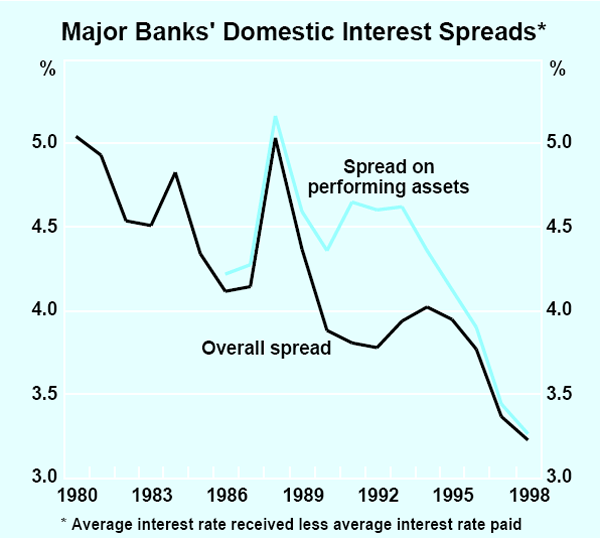
The downward trend in recent years reflects a larger fall in the average interest rate received by banks than in the average interest rate paid. The former effect reflects the narrowing of margins on housing and small business loans: the rate on standard variable rate housing loans has fallen by 1.3 percentage points more than the cash rate since mid 1996; in 1998, the average variable-rate on small business loans has fallen by 0.7 of a percentage point relative to the cash rate. Banks' cost of funds has fallen by less than the reduction in the overnight cash rate, in part, because rates paid by banks on some deposits, particularly transaction accounts, were already low during the recent phase of easing in monetary policy and could not be reduced pari passu with the cash rate.
Financial intermediation
Total credit provided to the private sector by financial intermediaries grew at an annual rate of 9.6 per cent over the six months to June (Table 4). While still a robust rate of increase in an economy in which nominal incomes are growing at around 6 per cent, this represents a moderate slowdown in the pace of financial intermediation from rates recorded in the second half of last year. Within the total, credit to households has picked up slightly, while the rate of expansion of business credit has declined. After the strong pick-up seen in the second half of 1997, business credit is now growing at a more moderate pace.
| Six months to: | |||
|---|---|---|---|
| June 1997 | December 1997 | June 1998 | |
| Total credit | 10.3 | 12.6 | 9.6 |
| – Personal | 9.0 | 16.6 | 14.3 |
| – Housing | 12.2 | 9.8 | 12.1 |
| – Business | 9.1 | 14.2 | 6.7 |
| Currency | 7.6 | 7.4 | 6.7 |
| M1 | 19.6 | 11.3 | 10.8 |
| M3 | 11.7 | 2.8 | 8.3 |
| Broad money | 11.1 | 4.8 | 7.2 |
The growth in housing credit outstanding reflects the net effect of new lending and loan repayments. The increases in new loan approvals recorded through most of 1997 did not lead to an increased rate of growth in loans outstanding, because principal repayments were increasing at the same time. Households were responding to declining interest rates by paying off their loans more quickly rather than reducing loan payments. In recent months, as discussed in the section on Domestic Economic Activity above, housing loan approvals have stabilised after the strong growth recorded earlier, but they remain at a high enough level to generate continued strong growth in the value of loans outstanding.
Following a period of weakness, growth in the broader deposit-based aggregates, M3 and broad money, has picked up in the past few months. The increase in broad-money growth, to an annualised rate of around 7 per cent over the six months to June, brings it more into line with the growth in credit. This followed a period in the second half of 1997 when banks had been funding a significant part of their credit expansion from other sources, principally offshore borrowing and a reduction in holdings of government securities. Growth in currency over the six months to June was marginally lower than over the previous six months, and, on the most recent figures, appears to have eased a little further, possibly reflecting moderation in the growth of consumer spending.
Funds under management grew strongly in the March quarter, to continue the trend seen over the past three years. There is little evidence of this trend slowing in the near term. Over the year to the March quarter, growth in total assets of managed funds has been strongest in the cash management and public unit trust sectors (Table 5). Assets of equity trusts have grown particularly strongly, to be up by 8 per cent in the March quarter and by nearly 40 per cent over the year. Underpinned by mandatory contributions, assets managed by superannuation funds continue to grow strongly. Valuation effects have contributed around half of the asset growth over the past year in life offices and superannuation funds. Funds managed by friendly societies continue to contract.
| Year to March 1996 |
Year to March 1997 |
Year to March 1998 |
March quarter 1998 |
|
|---|---|---|---|---|
| Cash management trusts | 24.7 | 41.5 | 34.8 | 4.2 |
| Unit trusts | 16.5 | 29.2 | 31.7 | 5.5 |
| of which: | ||||
| – Property trusts | 13.6 | 21.8 | 23.0 | 0.9 |
| – Equity trusts | 23.2 | 35.5 | 38.4 | 8.1 |
| – Mortgage trusts | 26.8 | 31.8 | 30.3 | 4.1 |
| Life offices | 8.9 | 8.9 | 9.9 | 0.9 |
| Superannuation funds | 17.5 | 15.5 | 20.9 | 4.2 |
| Total | 13.4 | 14.8 | 18.3 | 3.1 |
Sources: ABS Cat. Nos 5655.0 and 5645.0. |
||||
The growth of funds under management in recent years has been encouraged by the high average rates of return yielded by these investments relative to those that can be earned on traditional savings vehicles. While the volume of bank fixed deposits has been little changed over the past 18 months, funds under management have increased by $94 billion. The search for higher returns has also resulted in a sharp increase in direct investment in the share market by households. A recent survey by the Australian Stock Exchange found that around 29 per cent of the adult population directly owned shares, up from 16 per cent four years ago and 9 per cent a decade ago. This proportion will increase further following the strong retail exposure to the United Energy, AMP and NSW TAB floats subsequent to the survey. Reflecting this change, household income derived from dividends has almost doubled over the past four years.
Household balance sheets
While household saving rates have been fairly stable throughout the 1990s, household assets and liabilities have expanded rapidly, increasing as a proportion of household disposable income. This accumulation in assets and liabilities has seen marked changes in the composition of household balance sheets. As households have simultaneously increased their debt levels and equity holdings, they are now much more exposed to changes in interest rates and equity prices than has been the case in previous cycles.
Despite the increasing exposure to financial markets, household sector balance sheets remain strong, with their aggregate net financial assets rising by around 14 per cent over the year to the March quarter 1998. In the March quarter, households' liquid financial assets (excluding superannuation) were around 125 per cent of household disposable income, comfortably exceeding their financial liabilities, which were around 100 per cent of household disposable income. The ratio of total household debt to the value of the housing stock has, until recently, been increasing, but remains a little below the peak of the late 1980s (Graph 28). In the past year, house price increases have reduced this ratio somewhat, suggesting that there remains a substantial reserve of housing equity acting as collateral on bank loans. Of course, these aggregate indicators hide some significant dispersion in the pattern of asset and liability holdings across households. Certain categories of households, notably recent home-buyers, will have considerably greater debt exposures than the average.
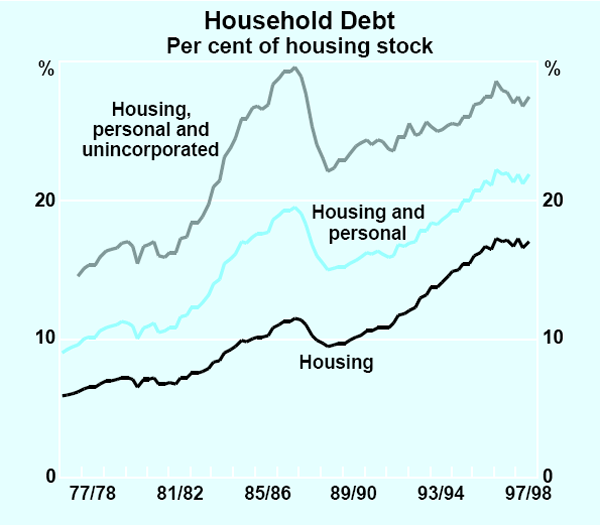
Inflation Trends and Prospects
Recent developments in inflation
Consumer prices
Inflation remains low and has risen only marginally from the trough it reached at the end of 1997. In underlying terms, consumer prices rose by 0.4 per cent in the June quarter to be 1.6 per cent higher over the year (Graph 29). At a quarterly rate, the increases in the March and June quarters (0.5 and 0.4 per cent) show a small pick-up after a succession of increases of 0.3 per cent in 1997. The small increase in inflation in the past two quarters mainly reflects the withdrawal of the earlier disinflationary impact from declining import prices. As discussed below, the recent currency depreciation can be expected in time to give a significant boost to import prices at the retail level, but the main impact has yet to flow through.
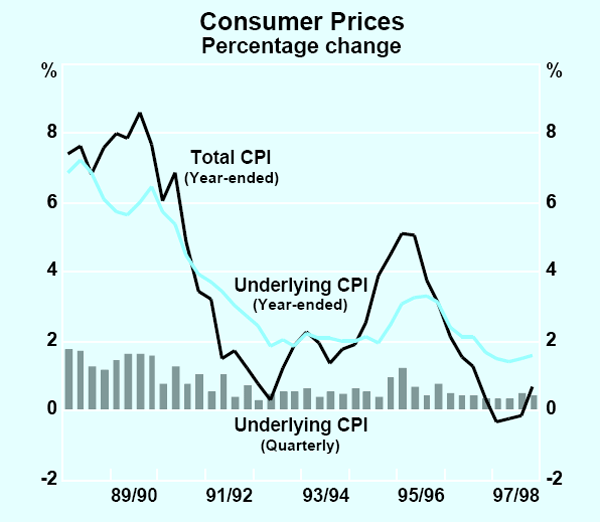
In headline terms, consumer prices rose by 0.6 per cent in the June quarter to be 0.7 per cent higher than a year earlier. The increase over the past year has continued to be held down by declines in mortgage interest charges, the last of which occurred in the September quarter 1997. With housing interest rates having been broadly stable since then, the quarterly increases for the CPI and the underlying measure have subsequently moved closer together. From the September quarter 1998, the Australian Statistician will introduce the 13th Series CPI, which makes a number of changes to the scope and coverage of the index. From a practical point of view, the most important change is the adoption of an ‘acquisitions’ approach to the measurement of housing costs, which will have the effect of removing mortgage interest rates from the index.
The rate of increase in private-sector service prices is currently running at just over 3 per cent, while prices of domestically produced goods increased by around one per cent over the past year, having slowed significantly during the past two years. After two years of almost continuous declines, import prices at the retail level showed little net movement over the March and June quarters, although they remain below their level of a year earlier.
The exchange rate and import prices
The decline in the exchange rate over the past year has had an important impact on import prices at the wholesale level that will eventually flow through to retail prices. At the docks, import prices have increased by around 10 per cent over the four quarters to June. To date, this has had little effect on retail prices. There was a noticeable increase in the imported-goods component of the CPI in the March quarter, but in the June quarter this movement was reversed. Much of this rise and subsequent decline was accounted for by the prices of imported motor vehicles. No growth was recorded in the prices of other predominantly imported goods in the June quarter. These developments illustrate that the pass-through of wholesale price changes to final retail prices is usually slow, and can vary depending on conditions in domestic product markets.
The relationship between the exchange rate and developments in the wholesale prices of imported goods is being complicated at present by the widely divergent movements in trading-partner exchange rates. The import-weighted exchange rate has depreciated over the past year by around 7 per cent which, on the basis of past behaviour, would usually contribute to a somewhat smaller change in imported goods prices over the same period. The actual increase has been noticeably larger. As Graph 30 illustrates, the rise in the over-the-docks price of imports in the past year has been more consistent with, although smaller than, the decline of the Australian dollar against the major currencies in the industrialised world (of which the exchange rate against the SDR is a convenient measure).
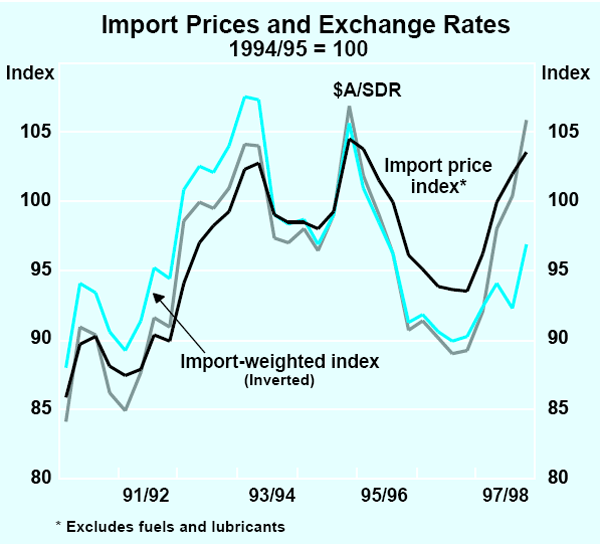
This relationship suggests that the major industrialised countries are having a greater role in influencing the prices of Australia's imports than their share of Australia's trade would imply. Nonetheless, the exchange rate movement against the major currencies must overstate the net impact of the recent currency movements because it does not take account of Asian producers' ability to reduce their prices. Although data on export prices for the Asian countries are fairly scarce, evidence from South Korea shows their export prices have fallen significantly in world currency terms, stimulating strong growth in their export volumes.
Producer prices
Softness in world commodity markets, as discussed in the section on Balance of Payments earlier, has also affected Australian producer prices. While the over-the-docks prices of imported final goods increased by more than 10 per cent over the past year, prices of imported inputs into manufacturing rose by 6 per cent and the prices of domestically sourced raw materials fell (Table 6). In both cases, this primarily reflected recent falls in energy prices.
| June quarter 1998 | Year to June 1998 | |
|---|---|---|
| Input prices | ||
| Domestic | ||
| – Raw materials | 0.1 | −1.3 |
| – Intermediate(a) | 0.2 | 1.5 |
| Imported | 1.9 | 6.0 |
| Final manufacturing prices(a) | ||
| Domestic | 0.2 | 1.5 |
| Imported | 1.3 | 10.6 |
| Construction prices | ||
| House-building materials | 0.3 | 1.7 |
| Other building materials | 0.4 | 0.5 |
| Import prices | ||
| Import price index(a) | 1.5 | 10.6 |
| Imported goods component of CPI(a) | −0.5 | −1.6 |
| (a) Excludes petroleum. | ||
Developments in input costs and selling prices presented in the business surveys have broadly lined up with these official data. Input costs are widely reported to have increased following the depreciation of the exchange rate. The NAB survey (which covers the entire non-farm economy) points to a modest increase in prices over the past year. Manufacturing sector surveys, such as the ACCI-Westpac, Colonial State Bank and Australian Chamber of Manufacturers' surveys, suggest there were sharp increases in input costs in the first half of this year, and point to further pressures in the September quarter. On selling prices, the picture is more mixed; surveys of retailers and manufacturers suggest growth in final goods prices has remained subdued, while some price pressure is evident at the wholesale level.
Labour costs
Ordinary-time earnings of adults working full time (AWOTE) increased by 0.4 per cent in the three months to May, and by 4.1 per cent over the past year (Graph 31). The increase in this measure of wages continues to display considerable short-run volatility. Nonetheless, there are some signs that its rate of growth has slowed. In the first half of 1998, AWOTE increased at an annual rate of 3.6 per cent, compared with annual increases of around 4 per cent prevailing over much of the preceding two-year period.
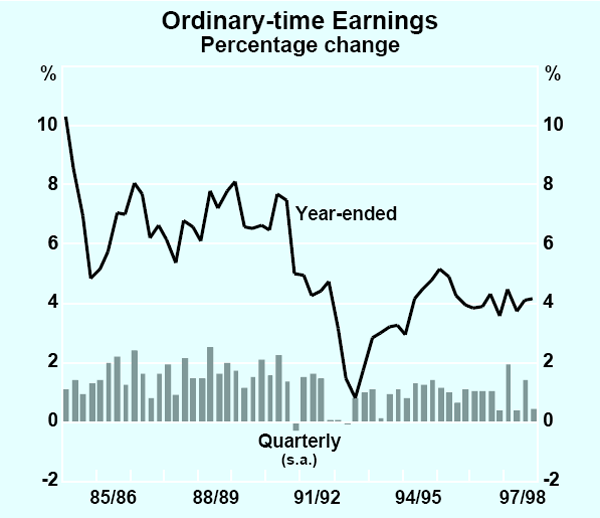
Some confirmation that aggregate wage growth is running at around the 3½ per cent mark is provided by the newly produced wage cost index. The first two available observations for the change in wage costs, covering the December and March quarters, show increases of 0.8 and 0.9 per cent, broadly consistent with what appears to be the trend rate of growth in economy-wide AWOTE (Table 7). However, despite the conceptual superiority of the wage cost index (it is, in principle, unaffected by compositional change and changes to the working week), longer experience with the index will be needed to assess its reliability.
| December 1997 |
March 1998 |
June 1998 |
Latest six months annualised |
|
|---|---|---|---|---|
| Wage Cost Index | ||||
| Private | 0.8 | 0.9 | – | 3.4 |
| Public | 0.7 | 1.0 | – | 3.4 |
| Total | 0.8 | 0.9 | – | 3.4 |
| AWOTE | ||||
| Private | 0.5 | 1.3 | – | 3.7 |
| Public | 0.3 | 1.9 | – | 4.4 |
| Total | 0.4 | 1.4 | 0.4 | 3.6 |
The increases awarded under new enterprise bargains have declined over the past year. From a peak of over 5 per cent in private-sector increases, reached in mid 1996, the rate of increase specified in new agreements has declined to 4 per cent in the March quarter 1998, and is likely to have been around the same in the June quarter. A similar trend can be seen from comparisons of new agreements with the expiring agreements they replace (Graph 32). Over the past year, replacement agreements in major enterprises have, on average, specified lower wage rises than the corresponding agreements previously operating. The average difference over the year has been around 1½ percentage points.
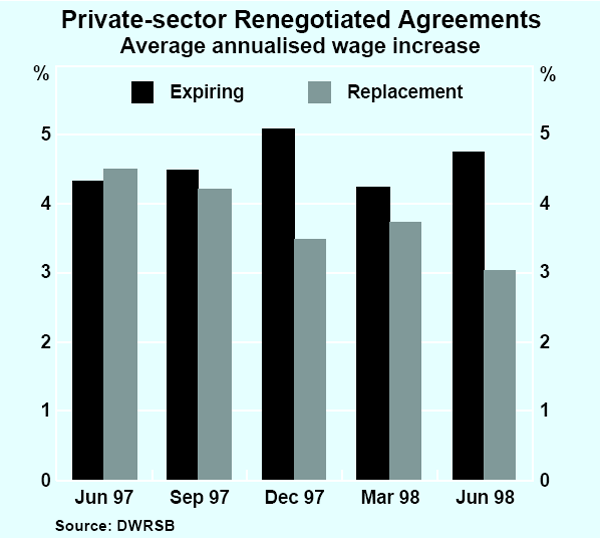
Inflation expectations
After declining to low levels in 1997, consumers' inflation expectations, as surveyed by the Melbourne Institute, increased slightly in the first half of this year, most probably in anticipation of the impact of the lower Australian dollar on prices. In June, when there was a sharp fall in the value of the currency, median inflation expectations rose sharply, from 3.4 per cent to 4.5 per cent, their highest rate in two years. Significantly, almost half of the survey's respondents reported hearing news about the exchange rate during the previous month. The latest survey reading, conducted in July when markets were calmer, showed that inflation expectations had dropped back to 3.4 per cent, close to their level throughout the early months of the year (Graph 33).
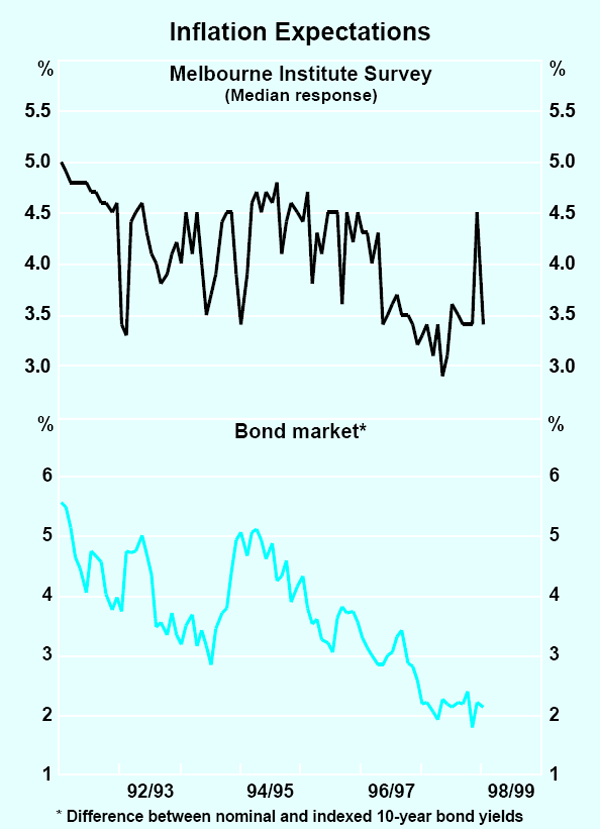
Survey evidence of businesses' inflation expectations provides mixed results on the near-term outlook. The latest ACCI-Westpac survey contained a sharp increase in the net balance of respondents expecting to raise prices in the September quarter, and the ACM survey also shows an expected pick-up in selling prices from a couple of quarters ago. Both of these are manufacturing-based surveys and are likely to reflect recent increases in the costs of imported inputs. The broader NAB survey found an average expected price increase of 0.4 per cent in the September quarter, which is little changed from recent quarters. At a longer-term horizon, firms' inflation expectations have eased slightly. The number of respondents to the NAB survey anticipating inflation to be greater than 3 per cent over the next ten years declined in the latest survey, although it remains the case that an expected inflation rate in the 3 to 4 per cent range is the most common survey response.
A survey of trade union officials, conducted by ACIRRT (Australian Centre for Industrial Relations Research and Training) following release of the June quarter CPI, gave a median inflation forecast of 2 per cent over the year to June 1999, rising to 3 per cent over the year to June 2000 (Table 8). The Bank's survey of financial market economists, also taken just after the June quarter CPI release, obtained a median forecast of underlying inflation over the year to June 1999 of 2.5 per cent, down from a forecast of 2.9 per cent obtained in the corresponding survey a year earlier. Respondents to this survey expect inflation to decline over the following year, to a median of 2.4 per cent.
| Year to June 1999 Per cent | Year to June 2000 Per cent |
||
|---|---|---|---|
| July 1997 survey | July 1998 survey | July 1998 survey | |
| Market economists(a) | |||
| Headline | 3.6 | 2.6 | 2.5 |
| Underlying | 2.9 | 2.5 | 2.4 |
| Union officials (b) | |||
| ‘Inflation’ | 2.6 | 2.0 | 3.0 |
| (a) RBA survey of financial market economists. (b) ACCIRT survey of trade union officials. This survey does not explicitly distinguish between underlying and headline inflation measures. |
|||
Inflation outlook
The major short-term influence on the inflation outlook continues to be the substantial decline in the Australian dollar over the past year. The currency depreciation will give a significant boost to import prices, lifting the overall inflation rate further above the trough reached in the December quarter 1997. Recent developments, including a further net decline in the exchange rate over the past few months, appear to have marginally increased the prospective inflation rate in the near term. However, this impact comes at a time when other sources of inflationary pressure are well contained.
By early August, the Australian dollar had depreciated by an average of around 15 per cent against the major currencies, from the levels prevailing in mid 1997, but there are several reasons to expect that the effect on domestic inflation might be smaller than would normally be expected from a movement of this size. At the wholesale level, import price increases are being limited by an increasingly tough international competitive environment, particularly where east Asian producers have been able to reduce their export prices in international currency terms. Domestic sources of inflationary pressure are likely to remain subdued. Labour markets are showing increasing evidence of an easing in wage pressures, and recent declines in business confidence may prompt a tougher stance by businesses in wage negotiations.
The net effect of higher import prices and continued subdued domestic inflationary pressures is likely to be a moderate rise in inflation during the period in which import prices are adjusting. The inflation rate is projected to peak at around 2½ to 3 per cent in the second half of 1999, after which, on current indications, it would decline to around the bottom of the target range. A source of risk for the inflation outlook in the short term might arise if there were a significant further weakening in the international environment, putting downward pressure on the currency. However, these effects would be partially offset by the accompanying dampening influence on demand and activity, which could reduce domestically sourced inflationary pressures.
Footnote
The interest spread is defined as the difference between the average interest rate received on interest-earning assets less the average interest rate paid on all deposits. A more complete discussion of Banks' Interest Spreads is contained in Box E of the Semi-Annual Statement on Monetary Policy, November 1997. [1]